Topic pack - International economics - introduction
Welcome to this Triple A Learning topic pack for International economics. The pack has a wide range of materials including notes, questions, activities and simulations.

A few words about Navigation
So that you can move to the next page in these notes more easily, each page has navigation tools in a bar at the top and the bottom. These tools are shown below.
![]() The right arrow at the top or bottom of the page will take you to the next page of content.
The right arrow at the top or bottom of the page will take you to the next page of content.
![]() The left arrow at the top or bottom of the page will take you to the previous page.
The left arrow at the top or bottom of the page will take you to the previous page.
![]() The home button will take you back to the table of contents for the pack.
The home button will take you back to the table of contents for the pack.
The pack is split into a series of sections and to access each section, the easiest way is to use the table of contents on the left-hand side of the page. To return to the full table of contents, please click on the 'home button' at any stage.
Higher level extension material
Some of the material in this pack relates to the higher level extension topics in the Economics guide. This material is marked by icons as follows:

This icon indicates the start of the higher level extension material.

This icon indicates either:
- The higher level extension material continues on the next page or
- The higher level extension material continues from the previous page

This icon indicates the end of the higher level extension material.
To start viewing the contents of the pack, please click on the right arrow at the top or bottom of the page.
Key terms - international trade
One of the key things you need to be sure to know are the definitions of all key international economics terms. In this section we give you explanations and definitions of terms relevant to international trade.

If you would prefer to view this interaction in a new web window, then please follow the link below:
Key terms - exchange rate
One of the key things you need to be sure to know are the definitions of all key international economics terms. In this section we give you explanations and definitions of terms relevant to exchange rates.

If you would prefer to view this interaction in a new web window, then please follow the link below:
Key terms - balance of payments
One of the key things you need to be sure to know are the definitions of all key international economics terms. In this section we give you explanations and definitions of terms relevant to the balance of payments.

If you would prefer to view this interaction in a new web window, then please follow the link below:
Key terms - economic integration
One of the key things you need to be sure to know are the definitions of all key international economics terms. In this section we give you explanations and definitions of terms relevant to economic integration.

If you would prefer to view this interaction in a new web window, then please follow the link below:
Key terms - terms of trade
One of the key things you need to be sure to know are the definitions of all key international economics terms. In this section we give you explanations and definitions of terms relevant to the terms of trade.

If you would prefer to view this interaction in a new web window, then please follow the link below:
International Organisations
In this section we take a look at international organisations that regulate, monitor and support world trade. We also look at organisations that support development in less developed countries.
If you would prefer to view this interaction in a new web window, then please follow the link below:
Aims of the economics course
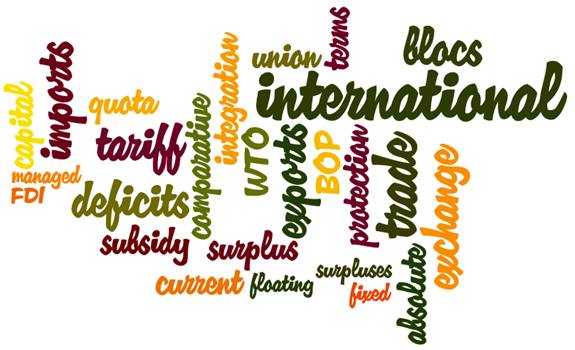
The aims of the economics course at HL and SL are to enable students to:
- develop an understanding of microeconomic and macroeconomic theories and concepts and their real-world application
- develop an appreciation of the impact on individuals and societies of economic interactions between nations
- develop an awareness of development issues facing nations as they undergo the process of change.
Assessment Objectives
Having followed the economics course at HL or SL, students will be expected to:
- AO1 Demonstrate knowledge and understanding of specified content
- Demonstrate knowledge and understanding of the common SL/HL syllabus
- Demonstrate knowledge and understanding of current economic issues and data
- At HL only: Demonstrate knowledge and understanding of the higher level extension topics
- AO2 Demonstrate application and analysis of knowledge and understanding
- Apply economic concepts and theories to real-world situations
- Identify and interpret economic data
- Demonstrate the extent to which economic information is used effectively in particular contexts
- At HL only: Demonstrate application and analysis of the extension topics
- AO3 Demonstrate synthesis and evaluation
- Examine economic concepts and theories
- Use economic concepts and examples to construct and present an argument
- Discuss and evaluate economic information and theories
- At HL only: Demonstrate economic synthesis and evaluation of the extension topics
- AO4 Select, use and apply a variety of appropriate skills and techniques
- Produce well-structured written material, using appropriate economic terminology, within specified time limits
- Use correctly labelled diagrams to help explain economic concepts and theories
- Select, interpret and analyse appropriate extracts from the news media
- Interpret appropriate data sets
- At HL only: Use quantitative techniques to identify, explain and analyse economic relationships
Section Three Structure
Unit three has four core sub-topics and one HL extension.
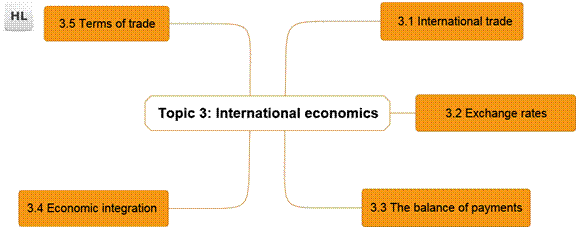
Section 3.1 International trade (notes)
In this section we will look at the benefits of trade, absolute and comparative advantage, the World Trade Organisation (WTO), types of trade protection and arguments for and against trade protection.
By the end of this section you should be able to:

- Explain that gains from trade include lower prices for consumers, greater choice for consumers, the ability of producers to benefit from economies of scale, the ability to acquire needed resources, a more efficient allocation of resources, increased competition, and a source of foreign exchange.
- Describe the objectives and functions of the WTO.
- Explain, using a tariff diagram, the effects of imposing a tariff on imported goods on different stakeholders, including domestic producers, foreign producers, consumers and the government.
- Explain, using a diagram, the effects of setting a quota on foreign producers on different stakeholders, including domestic producers, foreign producers, consumers and the government.
- Explain, using a diagram, the effects of giving a subsidy to domestic producers on different stakeholders, including domestic producers, foreign producers, consumers and the government.
- Describe administrative barriers that may be used as a means of protection.
- Evaluate the effect of different types of trade protection.
- Discuss the arguments in favour of trade protection, including the protection of domestic jobs, national security, protection of infant industries, the maintenance of health, safety and environmental standards, anti-dumping and unfair competition, a means of overcoming a balance of payments deficit and a source of government revenue.
- Discuss the arguments against trade protection, including a misallocation of resources, the danger of retaliation and "trade wars", the potential for corruption, increased costs of production due to lack of competition, higher prices for domestic consumers, increased costs of imported factors of production and reduced export competitiveness.

- Explain the theory of absolute advantage.
- Explain, using a diagram, the gains from trade arising from a country's absolute advantage in the production of a good.
- Explain the theory of comparative advantage.
- Describe the sources of comparative advantage, including the differences between countries in factor endowments and the levels of technology.
- Draw a diagram to show comparative advantage.
- Calculate opportunity costs from a set of data in order to identify comparative advantage.
- Draw a diagram to illustrate comparative advantage from a set of data.
- Discuss the real-world relevance and limitations of the theory of comparative advantage, considering factors including the assumptions on which it rests, and the costs and benefits of specialization.
- Calculate from diagrams the effects of imposing a tariff on imported goods on different stakeholders, including domestic producers, foreign producers, consumers and the government.
- Calculate from diagrams the effects of setting a quota on foreign producers on different stakeholders, including domestic producers, foreign producers, consumers and the government.
- Calculate from diagrams the effects of giving a subsidy to domestic producers on different stakeholders, including domestic producers, foreign producers, consumers and the government.
Reasons for trade - introduction
 Did you know that?
Did you know that?
- The total value of world trade in 2010 was $16 trillion; that's over $30 million a minute.
- World trade expanded an average 6 percent yearly between 1990 and 2008
On the following pages we consider the following topics in detail:
- Reasons for trade
- Theory of absolute and comparative advantage
- The World Trade Organisation
Benefits of trade
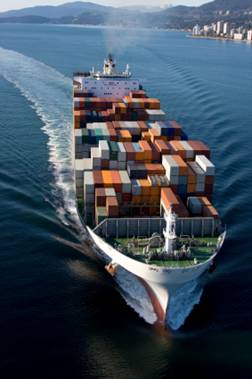 Why trade?
Why trade?
Countries trade for a number of reasons:
- Different factor endowments - some economies are rich in natural resources while others have relatively little. Trade enables economies to specialise in the export of some resources and earn revenue to pay for imports of other goods.
- Lower prices - one of the principal gains from trade is lower prices. The goods and services that consumers want are often available internationally cheaper than they would be domestically. The lower prices may arise as a result of the different factor endowments countries have. Comparative advantage (HL only topic) helps to explain these lower prices.
- Increased welfare - specialisation and trade allow countries to gain a higher level of consumption than they would do domestically, e.g. consume beyond their PPC.
- To gain economies of scale - with trade a country can get access to a larger market, and can therefore produce on a larger scale at a lower average cost. The process of specilisation within trade will often help countries to become increasingly skilled at production and therefore gain further economies of scale.
- Diversity of choice -through trade a country can provide a greater variety of goods and services therefore more choice to domestic consumers.
- Increased competition -global competition will encourage domestic firms to innovate, improve productivity and improve their products. This will benefit consumers through lower prices.
- Trade may be an 'engine for growth' - increased trade may encourage economic growth and drive further improvements in living standards, for instance improving the standards of living for millions of Chinese families.
- Availability of foreign exchange - by trading, countries can acquire foreign exchange. This is particularly important for countries like Ghana, North Korea and Cuba whose currencies are not convertible on international markets. The only way they can pay for imports is to export goods and be paid in foreigh exchange. This can then, in turn, be used to purchase imports.
Absolute advantage

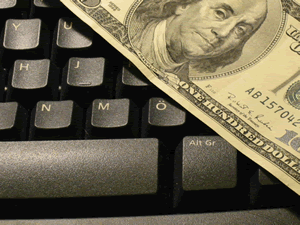 Did you know?
Did you know?
- Trade allows a country to specialise in the production of those products that it can produce most efficiently. A country will benefit from international trade as long as it exports goods for which it forgoes less other goods than other countries, and imports goods in which it has a higher opportunity cost of production than other countries.
In this section we look at how the theories of absolute and comparative advantage help explain the benefits of trade to a country, and to the World.
International trade is based on specialisation at a national level.
According to economic theory a country could benefit from trade if it specialises in the production of goods in which it has an absolute or comparative advantage (see below).
Theory of Absolute advantage
According to Adam Smith (1723-1790), each country should concentrate on producing those goods in which it has an absolute advantage.

Absolute advantage
Absolute advantage exists when a country can produce more of a product per resource unit than another country. It is a possible basis for trade. A country with an absolute advantage is producing more efficiently (at a lower cost per unit) than another.
Benefits of specialisation and trade:
- Consumers in each country can buy a wider range of goods at lower prices leading to a better standard of living
- There is a more efficient allocation of resources. i.e. better use of scarce resources
- More goods are produced in the World and more goods are available for consumption.

Comparative advantage

According to David Ricardo (1772 - 1823) countries will benefit from trade, not only when they have an absolute advantage, but also if they have a comparative advantage. It would be always beneficial for two countries to trade if they have different relative costs (opportunity cost) of producing a good.

Comparative Advantage
A country has a comparative advantage in producing a good, if it is able to produce the good at a lower opportunity cost (by sacrificing less production of other goods) than other countries,
Comparative advantage theory
The theory of comparative advantage is based on the following assumptions:
- There are no trade restrictions
- There are no transport costs
- There are no exchange rates
Suppose there are two countries - Utopia and Happyland. These countries produce two products - hardware and software. According to the theory of comparative advantage each country should specialise in production of a good where it has a lower opportunity cost.
Pre trade situation and opportunity costs
The graph below shows production possibilities for Utopia and Happyland.
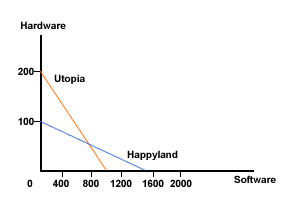
Figure 1 Production and consumption possibilities before trade
Assume that before trade each country uses a half of its resources to produce hardware and another half to produce software.
| Production and consumption | Hardware (units) | Software (units) |
|---|---|---|
| Utopia | 100 | 500 |
| Happyland | 50 | 750 |
| Total World | 150 | 1250 |
Utopia:
To produce 1 more Hardware Utopia has to give up 5 units of Software, e.g.
1 hardware = 5 Software
To produce software more Utopia has to give up 1/5 Hardware, e.g.
1 Software = 1/5 Hardware
Happyland:
To produce 1 more Hardware Happyland has to give up 15 units of Software, e.g.
1 hardware = 15 Software
To produce software more Happyland has to give up 1/15 Hardware, e.g.
1 Software = 1/15 Hardware
In conclusion, Utopia has a comparative advantage (lower opportunity cost) in production of Hardware and should specialise in production of Hardware.
Happyland has a comparative advantage (lower opportunity cost) in production of Software and should specialise in production of Software.
Specialisation
The table below shows specialisation based on comparative advantage.
| Hardware (units) | Software (units) | |
|---|---|---|
| Utopia (production) | 200 | 0 |
|
Happyland (production) |
0 | 1500 |
| Total production | 200 | 1500 |
Trade
As each country produces only one good, they will have to trade to be able to consume some of the other good. The terms of trade must settle somewhere between the two opportunity cost ratios to ensure that both countries benefit. As we saw earlier:
In Utopia 1 Hardware = 5 Software and in Happyland 1 Hardware = 15 Software, so the terms of trade (the world price) is 1 Hardware = 10 Software
If the countries agreed to trade 75 units of Hardware for 750 units of Software, then Utopia and Happyland will have the following amounts of Hardware and Software available for consumption:
| Hardware (units) | Software (units) | |
|---|---|---|
|
Utopia (consumption) |
125 | 750 |
|
Happyland (consumption) |
75 | 750 |
| Total production | 200 | 1500 |
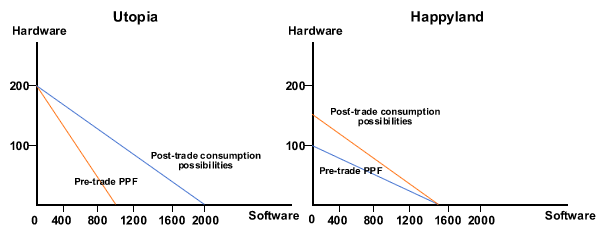
Both countries are better off from specialisation and trade, because they can reach higher levels of consumption of both goods than was possible before specialisation. After trade they are both able to consume beyond their production possibility curves.
Limitations of comparative advantage theory
- Transport costs and tariffs and exchange rates may change the relative prices of goods and may distort comparative advantages.
- Imperfect competition may lead to prices being different to opportunity cost ratios.
- Comparative advantage theory is a static theory and does not take account of some of the more dynamic elements determining world trade. In particular, the factor of production capital is not a natural resource, and so may come outside the scope of the theory.

Absolute and comparative advantage (video)


Watch the video International trade: absolute and comparative advantage and then answer the questions below. You can watch this in the window below, or follow the previous link to open the video in a new web window.

- While watching the video, draw the production possibility frontiers associated with the examples they give. Use these diagrams to explain which country has a comparative advantage for each DVDs and which country for wheat production.
- Suggest reasons why:
- Japan may have a comparative advantage in DVD production.
- South Africa may have a comparative advantage in wheat production.
- Discuss the relevance of comparative advantage theory in explaining the pattern of trade between Japan and South Africa.

World Trade Organisation (WTO)
What is the WTO?
The WTO has evolved from the General Agreement on Tariffs and Trade (GATT), which was originally established in 1947. There have been nine rounds of negotiations e.g. the 'Uruguay Round' that took place between 1986 and 1994. These negotiations were aimed at reducing tariffs for the facilitation of global trade on goods.
The WTO replaced GATT as the world's global trading body in 1995. The purpose of the WTO is to ensure that global trade is conducted freely. The WTO creates the legal framework for global trade among member nations in order to make the world trade easier and fairer. The new round of trade liberalisation talks started in the year 2000 and is ongoing.
Opponents of the WTO argue that as the WTO functions as a global authority on trade national sovereignty of member countries could be compromised. A country may have to sacrifice its own interests to avoid violating WTO agreements.

Further reading
For an excellent introduction to the WTO and the work they do, have a look at the 'What is the WTO' section of their web site. There is a useful guide - The WTO in brief, and a section looking at the 10 benefits of the WTO trading system. There is also a slide show about 50 years of work on the multilateral trading system that is well worth a look. For an excellent summary from the BBC site on the role of the WTO, go to What is the World Trade Organisation?

Success and failure of the WTO viewed from different perspectives
For this section, look at the range of views at the role of the WTO by following the links below.
- 10 benefits of the WTO - from the WTO web site
- 20 excellent reasons why the WTO is bad newsN.B. Please be warned that the tone and language of this posting are quite strident.
Browse these two links and make a note of the most important points for each side of the debate.
New WTO members in the order in which they acceded:
| 1. Ecuador | 12. Croatia |
| 2. Bulgaria | 13. Lithuania |
| 3. Mongolia | 14. Moldova |
| 4. Panama | 15. China |
| 5. Kyrgyz Republic | 16. Separate Customs Territory of Taiwan, Penghu, Kinmen and Matsu (Chinese Taipei) |
| 6. Latvia | 17. Armenia |
| 7. Estonia | 18. Former Yugoslav Republic of Macedonia (FYROM) |
| 8. Jordan | 19. Nepal (LDC) |
| 9. Georgia | 20. Cambodia (LDC) |
| 10. Albania | 21. Saudi Arabia |
| 11. Oman | 22. Viet Nam |
| 23. Tonga |
Source: http://www.wto.org/english/thewto_e/acc_e/cbt_course_e/c1s1p1_e.htm
For a complete list of WTO member countries see: http://www.wto.com/about/member-countries/
The role of the WTO
If you would prefer to view this interaction in a new web window, then please follow the link below:
WTO background information
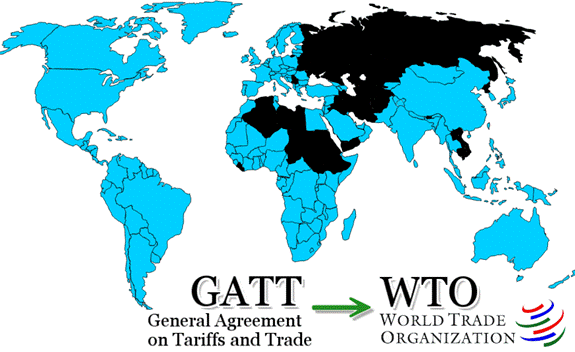
WTO members 2009

The following video gives some background information about the World Trade Organization and its predecessor, the General Agreement on Tariffs and Trade.

You might want to make some summary notes for revision purposes.
Trade protection - introduction
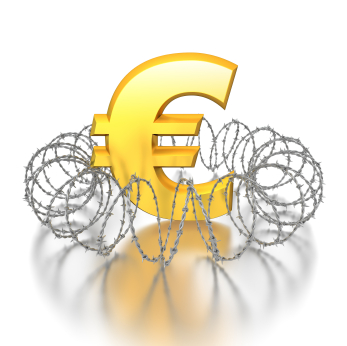 Did you know?
Did you know?
- The European Union spends around €55 billion on farm subsidies. In Zimbabwe, GDP per capita is $176 (http://en.wikipedia.org/ ).
On the following pages, we start to look at the different types of trade protection that are used and the arguments for and against protection. We consider the following topics in detail:
- Free trade
- Types of protectionism
- Arguments for protectionism
- Arguments against protectionism
Introduction to trade policies (video)

Watch the video International trade: introduction to trade policies and then answer the questions below. You can watch this in the window below, or follow the previous link to open the video in a new web window.

- Define the following terms:
- Trade policy
- Balance of payments
- Protectionism
- Tariff
- Explain how South Africa's trade policies have changed in the last 20 years.
- Analyse the impact of the move from subsidising the fruit industry to free trade on the South African fruit industry.
- Evaluate whether subsidies awarded to European farmers make them, as the video suggests, more competitive or more dependent.
- In the interview with Johann Baard of Cape Clothing Manufacturers he suggests that "South African clothing manufacturers can never, and never will, be competitive against clothing manufacturers in China." Discuss the extent to which this offers a justification for trade protection for South African clothing manufacturers.
- Explain the arguments offered in favour of tariffs.
Types of protectionism

Free trade
Free trade is trade that occurs between countries without any barriers or hindrances.
Protectionism has arisen in various forms. These include.
If you would prefer to view this interaction in a new web window, then please follow the link below:
If you would prefer to view this interaction in a new web window, then please follow the link below:
Tariffs - case study

Read the article US to Impose Tariff on Tires From China and watch the video Milton Friedman on the Dangers of Protectionism (Obama's recent tariff on Chinese imports). You can do this in the web windows below, or follow the previous links to open the article/video in a new web window.

The video below, while based around the decision to impose tyre tariffs, is based around an interview with Milton Friedman in 1980.

You may also like to read:
- China 'strongly opposes' Obama's tire import tariffs
- Americans will be punished by the punitive tariffs

- Explain the likely impact of the tariff on:
- US domestic tyre prices
- US tyre manufacturers
- Chinese tyre manufacturers
- Draw a diagram to illustrate these effects. Label it clearly to show:
- The change in revenue for US tyre manufacturers
- The tariff revenue
- The deadweight welfare loss as a result of the tariff
- Discuss the medium-term sustainability of using tariffs as a policy to protect jobs at US tyre manufacturers.
- Assess the extent to which Milton Friedman's arguments for free trade apply to this decision to impose tariffs on Chinese tyres.
Imposing a tariff - calculation


For higher level, you need to be able to understand how to calculate the impact of a tariff on a market. You will need to calculate this from linear demand and supply functions and to be able to calculate the change in consumer expenditure and the tariff revenue from the diagram. The presentation below goes through this. Click on the screenshot, or link below, to open the presentation. It will open in a new web window. You will need a headset or speakers to listen to the explanation.
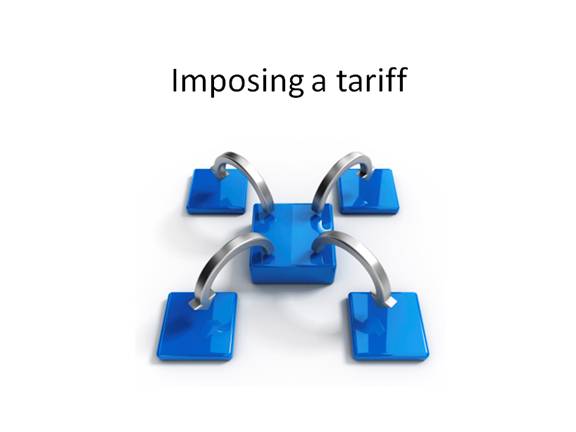
Imposing a tariff

Setting a quota - calculation


For higher level, you need to be able to understand how to calculate the impact of a quota on a market. You will need to calculate this from linear demand and supply functions and to be able to calculate the change in consumer expenditure and the domestic and overseas firm's revenue from the diagram. The presentation below goes through this. Click on the screenshot, or link below, to open the presentation. It will open in a new web window. You will need a headset or speakers to listen to the explanation.
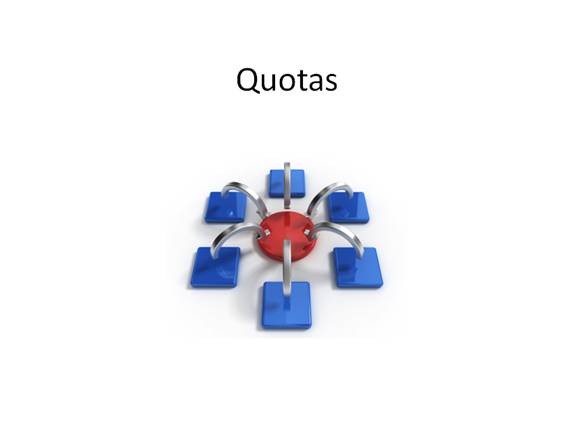
Impact of a quota

Giving a subsidy - calculation


For higher level, you need to be able to understand how to calculate the impact of a subsidy on a market. You will need to calculate this from linear demand and supply functions and to be able to calculate the change in consumer expenditure and the domestic and overseas firm's revenue from the diagram. The presentation below goes through this. Click on the screenshot, or link below, to open the presentation. It will open in a new web window. You will need a headset or speakers to listen to the explanation.
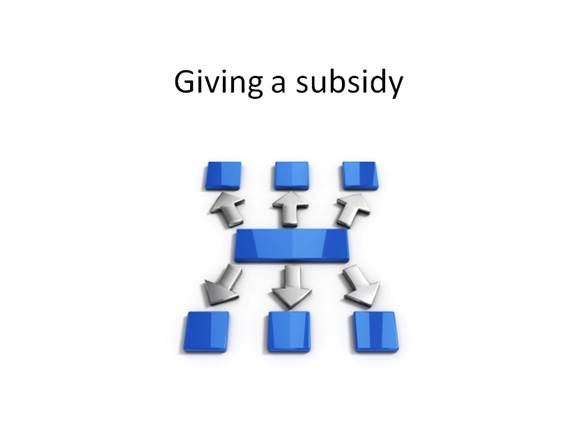
Giving a subsidy

Arguments for protectionism
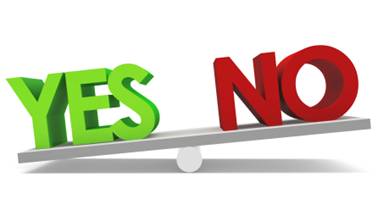 Governments use the following arguments to justify protectionism:
Governments use the following arguments to justify protectionism:
- To safeguard domestic employment - protectionist policies reduce the level of imports and increase aggregate demand [AD = C + I + G + (X-M)], resulting in a higher level of national output and employment.
- To correct balance of payments disequilibrium - as imports are discouraged, and exports encouraged, the balance of payments improves.
- To prevent labour exploitation in developing economies - preventing import of goods produced by exploiting cheap labour in developing countries will prevent this labour exploitation. However, it might also reduce export income and job opportunities for some of the poorest economies in the world.
- To prevent dumping - which is where economies sell goods in overseas markets at a price below the cost of production. Domestic consumers pay more than those buying overseas. Such low prices are part of a policy to destroy rivals in export markets.
- To safeguard infant industries - The new industries need some protection from the power of already established competitors to be able to grow and achieve economies of scale.
- To enable a developing country to diversify - Many developing countries are heavily dependent on exports of primary commodities. This can leave them very exposed to changes in international commodity prices. If they want to diversify and develop new export revenue streams, they may need to protect these new industries from full exposure to international competition for a while.
- Source of government revenue - where protectionism takes the form of a tariff, this will also raise revenue for the government, like any other tax.
- To protect strategic industries - a particular product or industry might be of strategic importance to a country, e.g. agriculture or coal, and protectionism may be justified on the grounds that it is keeping alive an industry which plays a vital part in the economy.
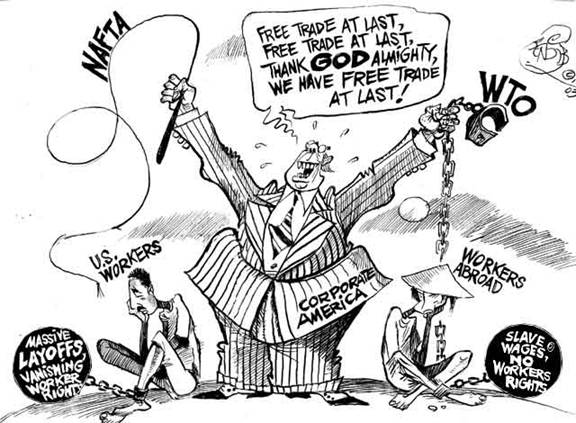

Question 1
Discuss the effects of free trade on:
- US corporations
- US workers
- workers abroad in developing countries.
Question 2
Suggest what the cartoonist believes about the role of NAFTA and WTO.

For this unit it is vital to be aware of up to date examples and issues. A useful way to find these is to search the Biz/ed In the News archive. You can do this in the window below, or right-click on the link and choose 'Open in a new window'.
Try searching on terms like:
- Protection
- Protectionism
- Trade
- Tariff
- Quota
Arguments against protectionism
 Various arguments are used against protectionism. These include:
Various arguments are used against protectionism. These include:
- Inefficiency of resource allocation in the long run - the imposition of tariffs, or other protectionist measures, in the long run results in losses of allocative efficiency. Protected producers are not exposed to international competition,do not have enough incentive to decrease costs or innovate and, in the long run, become less competitive and fall behind the rest of the world. In addition, tariffs increase prices in the domestic market and distort the price signals directing investments towards inefficient industries.
- Downward multiplier effects - if a country protects against imports, this will reduce the exports of other countries and their aggregate demand and national output. Consequently, they will import less as the level of imports is a function of national income level. This process could continue and result in a decrease in world production and income.
- Retaliation - protectionist measures tend to be met with some form of retaliation. This will mean that any success in protecting against imports is likely to result in a fall in exports.
- Loss of allocative efficiency (welfare loss) in the short run - a tariff leads to a reduction in imports and increases the price. There is a loss of consumer surplus (part of consumers' welfare shown as areas A, B, C and D in the diagram below). Some of the welfare loss is transferred to the government (tariff revenue shown as area C), and some to producers (shown as area A). There is also welfare cost to society (loss to consumers that is not transferred to anybody else) represented by areas B and D.
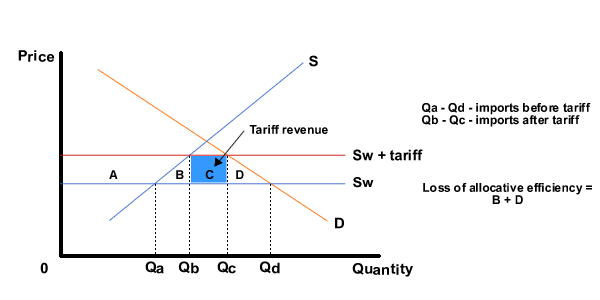
Figure 1 The impact of a tariff
- Bureaucracy - many protectionist measures are bureaucratic to enforce and result in extra cost to society.
However, completely free trade may also create additional costs to the economy and to society, for instance:
- Adjustment costs - changes in comparative advantage may require adjustments in the structure of industry, which may take some time and cause temporary increases in unemployment.
- Environmental costs - free trade may encourage firms to relocate to countries, where environmental and other regulations are more relaxed and compliance costs are lower. Although, this may increase producers' profits, it may lead to long-term environmental problems.
Section 3.1 International trade (questions)
In this section are a series of questions on the topic - international trade. The questions may include various types of questions. For example:
- Self-test questions - on-screen questions that give immediate marking and feedback
- Short-answer questions - a series of short-answer questions to help you check your understanding of the topic
- Numerical - calculation questions
- In the news - questions based around a topical economics news article
Click on the right arrow at the top or bottom of the page to work through the questions.
Reasons for trade - short answer

Question 1
Explain two reasons why countries may engage in international trade.
Question 2
Discuss the view that the main reason to trade internationally is to benefit from lower prices.
Question 3

With the use of suitable examples, explain how the law of comparative advantage and the concept of opportunity cost are linked.
Vietnam joins the WTO
Read the article World trade body admits Vietnam and then answer the questions below. You can either read the article in the window below or you can follow the previous link to read the article in a separate window.

Question 1
Explain the role of the World Trade Organisation (WTO) in the governance of world trade. You may find the WTO web site helpful in considering this.
Question 2
Examine the impact that membership of the WTO is likely to have on the Vietnamese economy.
Question 3
Use a suitable Internet search tool (e.g. Google news) to analyse the impact that recent actions of the WTO have had on the world trading system.
Russia's WTO membership bid backed by European Union
Read the article Russia's WTO membership bid backed by European Union and then answer the questions below. You can either read the article in the window below or you can follow the previous link to read the article in a separate window.

Question 1
Explain the significance of Russia's bid to join the WTO.
Question 2
Explain why the EU supported Russia's bid to join the WTO.
Question 3
Discuss the benefits of Russia joining the WTO to:
- Russia
- other countries
Types of protectionism - short answer

Question 1
Define the terms:
(a) Tariff
(b) Quota
(c) Voluntary Export Restraint
Question 2
Explain the ways in which a tariff distorts comparative advantage and international trade.
Question 3
Examine how a government raises money from quotas.
Arguments for protectionism - short answer

Question 1
Examine why many countries protect their domestic producers.
Question 2
Analyse the advantages and disadvantages of a government using Voluntary Export Restraints as compared to tariffs on imports.
International bread basket
Read the article Bread basket that is left to grow weeds and then answer the questions below. You can either read the article in the window below or you can follow the previous link to read the article in a separate window.

Question 1
Identify and explain three different forms of protectionism.
Question 2
Explain why the land identified in the article has been left uncultivated.
Question 3
Analyse the arguments for and against the reduction of tariff barriers to increase the production of food.
New Zealand apple growers bite back - trade & protectionism
Read the article NZ wins WTO appeal on Australia apple ban and then answer the questions below. You can either read the article in the window below or you can follow the previous link to read the article in a separate window.

Question 1
Explain why the Australian government originally banned the import of New Zealand apples.
Question 2
Analyse the costs and benefits of the trade in apples resuming between New Zealand and Australia for:
(a) Australian apple growers
(b) New Zealand apple growers
(c) The Australian economy
(d) The New Zealand economy
Question 3
Assess the methods used to resolve this dispute.
Fowl Play?
Read the article Fowl Play? and then answer the questions below. You can either read the article in the window below or you can follow the previous link to read the article in a separate window.

Question 1
Define the following terms from the article:
(a) Tariff
(b) Import penetration
(c) Dumping
Question 2
Describe what the Chinese authorities accused the US government of doing in the case of the trade in chicken, and earlier, for other products like movies and books.
Question 3
Outline why, and how, the US government supported their producers, including the producers of chicken.
Question 4
Identify, and explain, the action the Chinese authorities have taken. Analyse the likely effectiveness of this action in reducing US chicken imports and protecting domestic Chinese producers.
Dumping shoes on the EU
Read the article EU adopts shoe dumping penalties and then answer the questions below. You can either read the article in the window below or you can follow the previous link to read the article in a separate window.

Question 1
Explain what is meant by 'free trade'.
Question 2
Explain what is meant by the term 'dumping'.
Question 3
Examine the reasons why the EU decided to impose duties on shoes imported from China and Vietnam.
Question 4
Analyse the advantages and disadvantges of increased free trade.

Further research
There are a number of excellent resources available, which provide more information on free trade issues. For example, read the following articles from the BBC website:
- The argument for free trade
- A century of free trade - an excellent summary of the changes that have taken place in World Trade in the last 100 years.
- Debate - globalisation - good or bad - looking at the wider area of globalisation and the impact this has had on the world.
Lobby Groups
There are numerous non-government organisations (NGOs), such as charities and lobby groups, which campaign on the issue of free and fair trade. Have a look at the following:
- The rigged rules of global trade http://www.oxfam.org/en/campaigns/trade/rigged_rules
- FREE TRADE OR PROTECTIONISM http://www.isil.org/resources/lit/free-trade-protectionism.html (Beware ISIL = International Society for Individual Liberty "The world's premier freedom networking organization")
Protectionism in Europe
Read the article Protectionist stakes rise in Europe and then answer the questions below. You can either read the article in the window below or you can follow the previous link to read the article in a separate window.

You may also like to read the articles:

Question 1
Identify and explain three different forms of protectionism.
Question 2
Explain, with examples, the form that rising protectionism takes in Europe.
Question 3
Analyse two possible policies that the EU could use to reduce protectionism.
Imposing a tariff - numerical



- If the demand function is Qd = 170-5P and the supply function is Qs = -30+15P, calculate the figures for quantity demanded and quantity supplied for prices from $1 to $20.
- Use these figures to plot the supply and demand curves. What is the equilibrium price and quantity?
- The world price is $6, plot this on your supply and demand diagram.
- The government imposes a tariff of $2. Illustrate the impact of this on your diagram.
- Calculate the following:
- Domestic firm's revenue before and after the tariff
- Overseas firm's export revenue before and after the tariff
- Consumer expenditure before and after the tariff
- The government's revenue from the tariff
- Evaluate the impact of the tariff on domestic firms and consumers.

Setting a quota - numerical



- If the demand function is Qd = 150-5P and the supply function is Qs = -15+10P, calculate the figures for quantity demanded and quantity supplied for prices from $1 to $20.
- Use these figures to plot the supply and demand curves. What is the equilibrium price and quantity?
- The world price is $8, plot this on your supply and demand diagram.
- The government sets a quota for foreign firms of 15 units. Use your supply and demand diagram to illustrate the impact of this quota.
- Calculate the following:
- Domestic firm's revenue before and after the quota
- Overseas firm's revenue before and after the quota
- Consumer expenditure before and after the quota
- Evaluate the impact of the quota on overseas firms and consumers.

Giving a subsidy - numerical



- If the demand function is Qd = 190-5P and the supply function is Qs = -50+15P, calculate the figures for quantity demanded and quantity supplied for prices from $1 to $20.
- Use these figures to plot the supply and demand curves. What is the equilibrium price and quantity?
- The world price is $6, plot this on your supply and demand diagram.
- The government provides a subsidy of $4 per unit for domestic producers. Use your supply and demand diagram to illustrate the impact of this subsidy.
- Calculate the following:
- Domestic firm's revenue before and after the subsidy
- Overseas firm's export revenue before and after the subsidy
- Consumer expenditure before and after the subsidy
- The level of government expenditure on the subsidy
- Using your diagram, show the deadweight welfare loss that results from the subsidy.
- Assess the extent to which the subsidy will benefit domestic firms and consumers.
- Analyse the likely impact on the competitiveness of domestic firms receiving the subsidy.

Section 3.1 International trade - simulations and activities
In this section are a series of simulations and activities on the topic - international trade. These simulations and activities might include:
- Interactive diagrams - diagrams where you can drag curves or sliders to see the impact of the changes on the diagram
- PlotIT - a chance to build diagrams from data
Click on the right arrow at the top or bottom of the page to move on to the next page.
DragIT - Comparative advantage theory
The following diagram shows a production possibility curve. To keep the analysis simple, we assume that the country produces just two goods, wheat and computers.
Initially assume that production and consumption are at point P: the country produces and consumes 40 million tonnes of wheat and 60 million computers per year.
Now assume that trade occurs and that 1 tonne of wheat is exchanged for 1 computer. Assume also, that production remains at point P. By trading internationally, the country can consume anywhere along the straight red line linking 100 millions of tonnes of wheat with 100 million computers.
Drag the bullet at point P to show some of the alternative combinations of the two goods that can be consumed.
Drag the bullet to the top of the red line.

1 |
Imports and exportsAssuming that the country consumes at the point you have dragged the curve to (i.e. 100 million tonnes or wheat per year and no computers), how much will be imported and exported? |
Now drag the bullet to a consumption point that represents 20 million tonnes of wheat being exported and 20 million computers being imported.
2 |
DragIT - Tariffs (1)
To see the impact of a tariff on the level of imports, domestic production, government tax revenue and welfare losses, drag the tariff line in the following diagram up and down.

1 |
Tariff - tax revenueIf the government impose a higher tariff what will be the impact on government tax revenue from tariffs? |
2 |
Welfare lossA higher tariff will lead to a greater welfare loss. |
DragIT - Tariffs (2)
Drag the sliders in the simulation below to see the impact of changes in the world price and tariff.
DragIT - Tariffs (3)
Drag the sliders in the simulation below to see the impact of changes in the demand function, supply function, world price and tariff.
Section 3.2 Exchange rates (notes)
In this section we will look at freely floating exchange rates and government intervention in the foreign exchange market.
By the end of this section you should be able to:

- Explain that the value of an exchange rate in a floating system is determined by the demand for, and supply of, a currency.
- Draw a diagram to show determination of exchange rates in a floating exchange rate system.
- Describe the factors that lead to changes in currency demand and supply, including foreign demand for a country's exports, domestic demand for imports, relative interest rates, relative inflation rates, investment from overseas in a country's firms (foreign direct investment and portfolio investment) and speculation.
- Distinguish between a depreciation of the currency and an appreciation of the currency.
- Draw diagrams to show changes in the demand for, and supply of, a currency.
- Evaluate the possible economic consequences of a change in the value of a currency, including the effects on a country's inflation rate, employment, economic growth and current account balance.
- Describe a fixed exchange rate system involving commitment to a single fixed rate.
- Distinguish between a devaluation of a currency and a revaluation of a currency.
- Explain, using a diagram, how a fixed exchange rate is maintained.
- Explain how a managed exchange rate operates, with reference to the fact that there is a periodic government intervention to influence the value of an exchange rate.
- Examine the possible consequences of overvalued and undervalued currencies.
- Compare and contrast a fixed exchange rate system with a floating exchange rate system, with reference to factors including the degree of certainty for stakeholders, ease of adjustment, the role of international reserves in the form of foreign currencies and flexibility offered to policy makers.

- Calculate the value of one currency in terms of another currency.
- Calculate the exchange rate for linear demand and supply functions.
- Plot demand and supply curves for a currency from linear functions and identify the equilibrium exchange rate.
- Using exchange rates, calculate the price of a good in different currencies.
- Calculate the changes in the value of a currency from a set of data.
Exchange rates - introduction
Did you know?
The eight most traded currencies in the world (in no specific order) are the U.S. dollar (USD), the Canadian dollar (CAD), the euro (EUR), the British pound (GBP), the Swiss franc (CHF), the New Zealand dollar (NZD), the Australian dollar (AUD) and the Japanese yen (JPY).
Source: http://www.investopedia.com/ask/answers/06/maincurrencypairs.asp
Exchange rate systems

Exchange rate
An exchange rate is the price of one currency expressed in terms of another, e.g. 1 U.S. dollar = 30.13 Thai baht.
An exchange rate system is the way in which the exchange rate is determined.
On the following pages, we consider the following topics in detail:
- Floating exchange rates
- Changes in the exchange rate
- Effects of exchange rate changes
- Fixed exchange rates
- Managed exchange rates
Floating exchange rates
If you would prefer to view this interaction in a new web window, then please follow the link below:
Demand and supply of dollars (video)

Watch the videos Exchange rate 01: Demand for dollars and Exchange rate 02: Supply of dollars and then answer the questions below. You can watch these in the windows below, or follow the previous link to open the video in a new web window.

- Outline the main determinants of:
- The demand for dollars
- The supply of dollars
- Explain the difference between:
- A shift and a move of the demand curve for dollars
- A shift and a move of the supply curve for dollars
- Suggest three factors that would:
- Increase the demand for dollars
- Decrease the supply of dollars
Exchange rate appreciation
If you would prefer to view this interaction in a new web window, then please follow the link below:
If you would prefer to view this interaction in a new web window, then please follow the link below:
Exchange rate depreciation
If you would prefer to view this interaction in a new web window, then please follow the link below:
If you would prefer to view this interaction in a new web window, then please follow the link below:
Demand and supply of dollars (video)

Watch the video Exchange rate 03: Determining the Rand Dollar exchange rate and then answer the questions below. You can watch this in the window below, or follow the previous link to open the video in a new web window.

- Explain two factors that may cause an appreciation of the dollar against the rand.
- Draw a diagram to illustrate each of these changes.
- Discuss the possible consequences of the dollar appreciating against the rand for US and South African firms.
Advantages and disadvantages of floating exchange rates
Governments can use exchange rates to affect economic performance. A rising exchange rate, which is often linked to an increase in base interest rates, leads to exports becoming more expensive, but imports falling in price. This reduces part of the inflationary pressure within an economy. A fall in the exchange rate will lead to the reverse and may help domestic businesses export more.
If you would prefer to view this interaction in a new web window, then please follow the link below:

The New Zealand Dollar
Examples of some of the factors that can influence a floating currency, such as the New Zealand dollar (NZD) are indicated in the bullet points and the graph below.
The following exchange rate analysis came from BNZ Financial Markets Wrap, Feb 2011
- Early in the month an increase in risk appetite underpinned rises in global equity markets and bond yields.
- Later on risk aversion rose as political turmoil in the Middle-East once again took the stage.
- Global commodity prices continued to soar, underpinning strong returns from AUD, CAD and energy and materials sectors of world equity markets.
- The 22 February Christchurch earthquake resulted in markets immediately pricing RBNZ OCR cuts and a fall in the NZD.
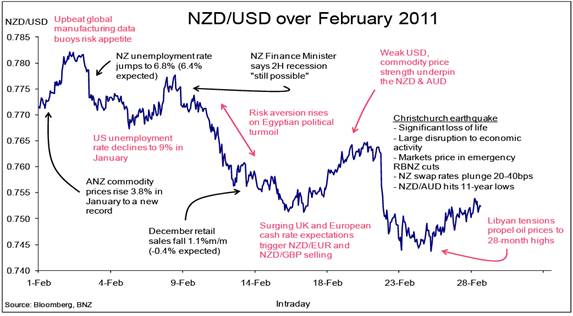
Source: BNZ Financial Markets Wrap, Feb 2011

Question 1
Explain why the currency depreciated following the bad news.
Question 2
Suggest reasons why the NZD appreciated following the increase in commodity prices.
Question 3
Analyse the possible links between the higher risk aversion and the depreciation in the NZD.
Exchange rate determination - calculation


For higher level, you need to be able to understand how to calculate the equilibrium exchange rate in a market. You will need to calculate this from linear demand and supply functions and to be able to plot the demand and supply curves for foreign exchange. You will also need to be able to calculate exchange rates and the prices of goods in other currencies. The presentation below goes through this. Click on the screenshot, or link below, to open the presentation. It will open in a new web window. You will need a headset or speakers to listen to the explanation.
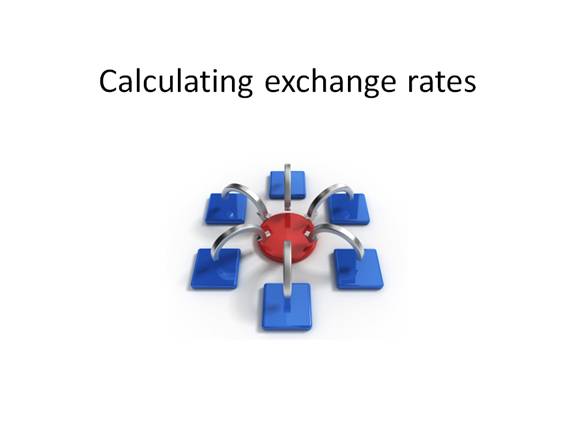
Calculating exchange rates

Causes of changes in exchange rate
As already shown, the exchange rate is affected by the state of the economy indicated by inflation, interest rates and balance on trade. We now consider these influences using the example of Australian economy.
Balance of trade
A surplus in the balance of trade (X>M) means that DAus$ > SAus$ , i.e. there is net increase in DAus$ . This causes an upward pressure on the exchange rate. The exchange rate will appreciate. This is illustrated in Figure 1 below:
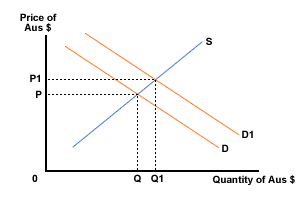
Figure 1 Australian trade surplus - impact on exchange rate
Alternatively, a deficit in balance of trade will result in net increase is SAus $ and result in downward pressure on the exchange rate as shown in Figure 2 below. The exchange rate will depreciate.
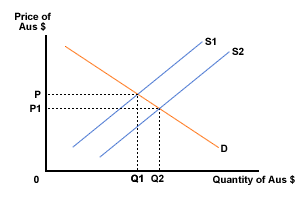
Figure 2 Australian trade deficit - impact on exchange rate
Interest rates
Differences in interest rates between different countries affect the investment flows (capital flows) between these countries and will, in return, affect the exchange rate
Capital flows exert a greater influence on exchange rates than trade flows. This is because the fund managers of international financial organisations and multinational corporations, and rich individuals, move more money around the globe on a daily basis than is accounted for by trade flows. They do this to take advantage of differences in relative interest rates and changes in exchange rates, or they may be speculating on future movements in such variables.
If interest rates were to fall below those in other major economies, or international speculators were pessimistic about the future of the Australian economy, or predict a large depreciation in the Australian $, they might decide to sell their holdings of Aus $ and convert them into yen. This would increase the demand for yen, while increasing the supply of Aus $'s, which causes a depreciation of the currency. This can be seen in Figure 3 below:
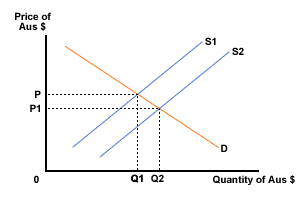
Figure 3 Australian capital outflows - impact on exchange rate
An increase in Australian interest rates relative to others, or greater optimism about the future of the Australian economy will enable investors to earn higher returns Consequently, speculators / fund managers might decide to move funds currently being held in yen into Aus $'s. This will have the reverse effect As the Aus $ will appreciate as the demand for it increases (indicated by a rightward shift of the demand curve for Aus $'s).
Inflation
A higher rate of inflation in Australia, than in other countries, will make Australian exports less competitive and may lead to less exports being sold, depending on the price elasticity of demand for exports. If this causes a worsening of the current account, the exchange rate will depreciate. With less demand for exports and imports becoming relatively cheaper, the demand for Aus $'s will fall, while the supply will increase. This is shown in Figure 4 below:
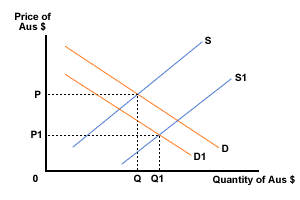
Figure 4 Impact of higher inflation on the exchange rate
The opposite might be the case, i.e. an appreciation of the Aus $, if the rate of inflation in Australia fell below that in other countries.
Inflation may also be a factor which currency speculators take into account when making decisions about buying/selling currencies. If a very high, uncontrollable rate of inflation was expected (hyper-inflation), speculators may lose confidence in the currency and sell, causing it to depreciate in value.
Effects of exchange rate changes
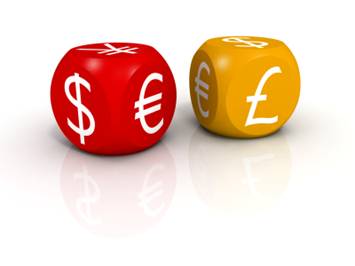 The government may influence the exchange rate in order to influence the economy. The government may influence the exchange rate directly by buying or selling the domestic currency from the currency reserves in the foreign exchange market. Alternatively the government can affect the exchange rate indirectly, by affecting the level of aggregate demand, employment, inflation and the balance of payments.
The government may influence the exchange rate in order to influence the economy. The government may influence the exchange rate directly by buying or selling the domestic currency from the currency reserves in the foreign exchange market. Alternatively the government can affect the exchange rate indirectly, by affecting the level of aggregate demand, employment, inflation and the balance of payments.
The government can, for example, increase the value of the exchange rate (by raising short-term interest rates) in order to decrease the prices of imports and reduce the import price-led inflation within the economy. However, this may cause export volumes to fall, especially if they are price sensitive (elastic) as well as leading to a fall in employment.
The government may also decrease the exchange rate to achieve some of its macroeconomic goals, such as improving the balance of payments (imports less competitive and exports more competitive) or increasing employment. However, higher import prices could cause import price led inflation.
Changes in exports
As we have seen, a depreciation of a currency will reduce the overseas price of exports, which should lead to an increase in demand for exports. The higher the price elasticity of demand for exports, the bigger the increase in demand for exports will be.
Changes in imports
A depreciation of a currency will increase the price of imports. This will lead to a decrease in the demand for imports, with the scale of the decrease depending on the price elasticity of demand for imports. If demand is very inelastic, then imports will change very little. If, on the other hand, demand is very elastic, then imports will change considerably.
Fixed exchange rates
If you would prefer to view this interaction in a new web window, then please follow the link below:
If you would prefer to view this interaction in a new web window, then please follow the link below:
Advantages and disadvantages of fixed exchange rates
If you would prefer to view this interaction in a new web window, then please follow the link below:
Managed exchange rates
Under the managed exchange rate system, the exchange rate is predominantly determined in the foreign exchange market by supply of and demand for a currency. The government intervenes only occasionally to influence the exchange rate when it considers it to be necessary.
There has been a reduction in central bank intervention in the developed countries over the last decade. However, any central bank still has the discretion to intervene if it feels conditions warrant. The central banks in many parts of the developing world still engage in intervention.

A recent example of a central bank's intervention on the foreign exchange market is Bank of Japan selling the yen after it spiked dramatically in the aftermath of the 2011 earthquake and tsunami. Moreover, in a show of sympathy the G7 countries joined the Bank of Japan in selling the yen.
Exchange rates are best when they are:
- Predictable
- Consistent
- Not open to 'outside' interference by speculators
Remember that a change in the exchange rate will cause changes in the prices of imports and exports. An increase in the exchange rate will cause export prices to rise and import prices to fall, while a decrease in the exchange rate will cause export prices to fall, but import prices to rise.

Task (1)
Go to an exchange rate site (try Oanda.com) or statistics site and find exchange rates for the last couple of years for the country where you are, against one of the major worldwide currencies (e.g. the euro, dollar or sterling). Plot these figures and assess what impact the changes are likely to have had on the balance of payments on current account.
Then, find out the figures for the current account and see if your expectations were correct. Identify other factors that may have been responsible for the balance of payments changes.

Task (2)
Identity the type of exchange rate system operating in your country. If it is a fixed rate system, find out the level of the fixed rate and any revaluations and devaluations there may have been. If the exchange rate is a floating system find figures for the exchange rate against three major currencies for the last 10 years and plot the figures on a graph. Mark on the graph the years where there have been a depreciation in the rate, and the years where there have been an appreciation in the rate.
Section 3.2 Exchange rates - questions
In this section are a series of questions on the topic - exchange rates. The questions may include various types of questions. For example:
- Self-test questions - on-screen questions that give immediate marking and feedback
- Short-answer questions - a series of short-answer questions to help you check your understanding of the topic
- Numerical - calculation questions
- In the news - questions based around a topical economics news article
Click on the right arrow at the top or bottom of the page to work through the questions.
Exchange rate movements - short answer

Question 1
Explain two factors which may cause an appreciation of a country's exchange rate under a floating exchange rate system.
Question 2
Explain how a government may try to influence the exchange rate.
Question 3
Compare and contrast a fixed and floating exchange rate system.
Question 4
Discuss whether a government should attempt to manage its currency's exchange rate.
Exchange rates - essay

Question 1
(a) Explain three factors, which may cause an appreciation of a country's exchange rate.
(b) Discuss the view that an exchange rate appreciation will always be beneficial for an economy.
Pound takes a dive
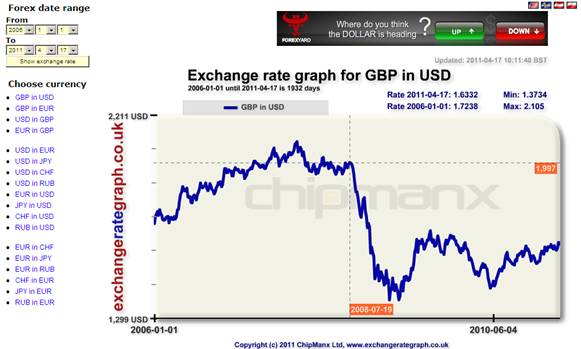
There are a number of excellent websites you can access to provide exchange rate graphs. The graph above shows the pound in US dollars from 2006 to 2011. With this particular site, you can set the currencies and dates required, and then move your cursor along the graph to read off the date and exchange rate.

Question 1
Referring to the graph above, describe the change in GBP / USD exchange rate in the months following July 2008.
Question 2
Analyse the likely impact of this change in value of the pound on the major UK economic targets.
Question 3
Select two policies the UK government can use to influence the value of sterling against the dollar and evaluate their likely success.
Destabilising currency flows
Read the article Asian heads stress currency risk and then answer the questions below. You can either read the article in the window below or you can follow the previous link to read the article in a separate window.

Question 1
Using diagrams as appropriate, show the impact of a rise in inward capital flows on the exchange rate of an Asian country.
Question 2
Analyse the likely economic impact of recent Thai restrictions on foreign ownership of Thai companies.
Question 3
"It is, and will surely be, the most difficult task for any monetary authorities to maintain the stability of foreign exchange rates, the free flow of capital, and the independence of monetary policy simultaneously...". Discuss the extent to which all these factors are interdependent.
The iPad index
Read the article Oz prices cheap says Commsec's iPad index and then answer the questions below. You can either read the article in the window below or you can follow the previous link to read the article in a separate window.

Question 1
Explain what the iPad index shows and how it might be used.
Question 2
Suggest possible reasons for the differences in price of iPad in the UK and Australia.
Question 3
Discuss the relevance of indices like the Big Mac index and iPad index for economists and policy-makers.
Exchange rates - G20 considers wider role for China's yuan
Read the article G20 considers wider role for China's yuan then answer the questions below. You can either read the article in the window below or you can follow the previous link to read the article in a separate window.

Question 1
Explain how the G20 leaders propose giving the Chinese yuan more of a role in global finance.
Question 2
Identify the requirements for a currency to join the SDR basket.
Question 3
Describe the criticisms that developed nations had of China's exchange rate policy.
Question 4
Analyse the reasons why the Chinese have been reluctant to allow a sudden appreciation of its currency.
Section 3.2 Exchange rates - simulations and activities
In this section are a series of simulations and activities on the topic - exchange rates. These simulations and activities might include:
- Interactive diagrams - diagrams where you can drag curves or sliders to see the impact of the changes on the diagram
- PlotIT - a chance to build diagrams from data
Click on the right arrow at the top or bottom of the page to move on to the next page.
DragIT - exchange rate determination (1)
Drag the sliders in the simulation below to see the impact of changes in the demand function and supply function on the equilibrium exchange rate.
DragIT - Exchange rate determination (2)
In a free foreign exchange market, the rate of exchange is determined by demand and supply. This is illustrated in the following diagrams, which show the demand and supply of pounds against the US dollar.
In the first diagram, you can drag the supply curve to see the impact of changes in supply, while in the second you can drag the demand curve.
NB For the sake of example, we have used the demand for and supply of sterling - the UK currency.

1 |
Exchange rate changesMatch the following events to the relevant shifts in the curves. (N.B. Bear in mind that we are looking at changes to the UK currency - sterling) |
2 |
Exchange rate changesMatch the following events to the changes they will cause to the demand and supply of sterling. |
Section 3.3 Balance of payments - notes
In this section we will look at the structure of the balance of payments and current account deficits and surpluses.
By the end of this section you should be able to:

- Outline the role of the balance of payments.
- Distinguish between debit items and credit items in the balance of payments.
- Explain the four components of the current account, specifically the balance of trade in goods, the balance of trade in services, income and current transfers.
- Distinguish between a current account deficit and a current account surplus.
- Explain the two components of the capital account, specifically capital transfers and transaction in non-produced, non-financial assets.
- Explain the three main components of the financial account, specifically, direct investment, portfolio investment and reserve assets.
- Explain that the current account balance is equal to the sum of the capital account and financial account balances (see the appendix, "The balance of payments").
- Examine how the current account and the financial account are interdependent.
- Explain why a deficit in the current account of the balance of payments may result in downward pressure on the exchange rate of the currency.
- Explain why a surplus in the current account of the balance of payments may result in upward pressure on the exchange rate of the currency.

- Calculate elements of the balance of payments from a set of data.
- Discuss the implications of a persistent current account deficit, referring to factors including foreign ownership of domestic assets, exchange rates, interest rates, indebtedness, international credit ratings and demand management.
- Explain the methods that a government can use to correct a persistent current account deficit, including expenditure switching policies, expenditure reducing policies and supply-side policies, to increase competitiveness.
- Evaluate the effectiveness of the policies to correct a persistent current account deficit.
- State the Marshall-Lerner condition and apply it to explain the effects of depreciation/devaluation.
- Explain the J-curve effect, with reference to the Marshall-Lerner condition.
- Discuss the possible consequences of a rising current account surplus, including lower domestic consumption and investment, as well as the appreciation of the domestic currency and reduced export competitiveness.
BOPs - introduction
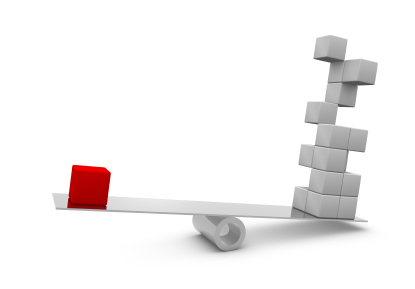 The balance of payments accounts record the financial flows between a country and the rest of the world. These flows result from trade, international investments, international borrowing and loan repayments.
The balance of payments accounts record the financial flows between a country and the rest of the world. These flows result from trade, international investments, international borrowing and loan repayments.
Overall, the balance of payments accounts will always balance, although there may be deficits or surpluses on the various sections within the overall accounts. If there is a deficit in the trade of goods and services recorded in the current account, this will then be paid for by an inflow of funds recorded in the financial account.
On the following pages, we consider the following topics in detail:
- Current account
- Capital account
- Financial account
Credits and debits
The balance of payments is a record of all financial flows between a country and the rest of the world. These flows are recorded as either credits or debits.

Credit
A credit item on the balance of payments is any financial flow that leads to money entering the country.

Debit
A debit item on the balance of payments is any financial flow that leads to money leaving the country.
Credit items will include any item where money enters the country. It is important to think of a credit as the money entering the country. For example, one of the principal credit items is exports. In the case of exports, the goods leave the country to be sold overseas, but the money enters the country. Exports are therefore a credit item. Credit items therefore include:
- Export receipts
- Current transfers into the country
- Capital transfers into the country
- Direct and portfolio investment into the country
In the same way, debit items will include:
- Imports payments
- Current transfers out of the country
- Capital transfers out of the country
- Direct and portfolio investment out of the country

Net
The term net in the balance of payments accounts is used to refer to the net of credits and debits. e.g. if credits are $5,000 and debits are $4,000 then the net figure is +$1,000.
Current account
 The current account records money flows from imports and exports of goods (the 'balance of trade' or 'visible balance') and imports and exports of services (sometimes 'invisible trade'). It also records income flows (flows of interest, profits and dividends that may have arisen from investment flows) and transfers of money.
The current account records money flows from imports and exports of goods (the 'balance of trade' or 'visible balance') and imports and exports of services (sometimes 'invisible trade'). It also records income flows (flows of interest, profits and dividends that may have arisen from investment flows) and transfers of money.
The current account balance is the net balance of all of these items.
The major components of the current account are:
- The balance of goods account
-
The balance of services account
When combined,these two accounts are commonly known as trade in goods and services account. A difference in the monetary value of exports and imports, in the trade in goods and services account, is known as the balance of trade. -
The balance of income
Income flows consist of investment income such as interest, dividends, and payments of profits and reinvested earnings on direct investment. -
The balance of current transfers
Current transfers consist of receipts and payments, where there is no corresponding exchange such as foreign aid and contribution to international organisations such as the European Union. This account also includes international transfers of money by private individuals, such as workers' remittances.
The balance of goods is also known as visible or merchandise balance, whereas the other three balances are sometimes referred to as the invisible balance.
The sum of the balances of the four components of the current account is known as the current account balance. A current account balance is in surplus if overall credits exceed debits and in deficit if debits exceed credits.
Capital account
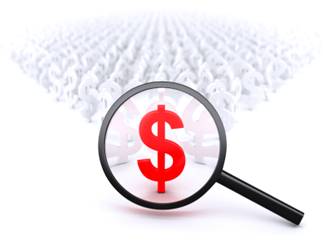 The capital account is a relatively small element of the balance of payments. It includes capital transfers, such as debt forgiveness and migrants' transfers. It also includes the acquisition and disposal of non-produced, non-financial assets, such as land purchases and sales associated with embassies and other extra-territorial bodies.
The capital account is a relatively small element of the balance of payments. It includes capital transfers, such as debt forgiveness and migrants' transfers. It also includes the acquisition and disposal of non-produced, non-financial assets, such as land purchases and sales associated with embassies and other extra-territorial bodies.
Financial account
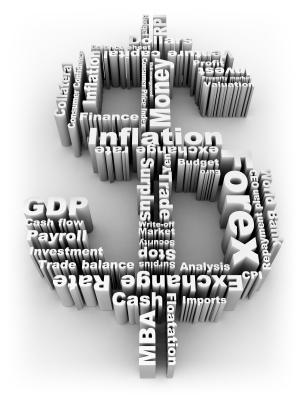 The financial account records transactions associated with changes of ownership of a country's foreign assets and liabilities. The financial account is divided into four main sub-accounts: direct investment, portfolio investment, other investment and reserve assets, each showing inflows of money (credits) and outflows of money from a country (debits).
The financial account records transactions associated with changes of ownership of a country's foreign assets and liabilities. The financial account is divided into four main sub-accounts: direct investment, portfolio investment, other investment and reserve assets, each showing inflows of money (credits) and outflows of money from a country (debits).
(i) Direct investment is productive investment. It is investment in plant, equipment, machinery or factories, i.e. investment that will help with the process of wealth creation.
(ii) Portfolio investment, on the other hand, is investment in paper assets like shares and government bonds. The only purpose of portfolio investment is financial gain, so they do not involve foreigners' participation in the management of the domestic firms. There may be both inflows and outflows of portfolio investment.
(iii) Other financial flows - this heading can cover a range of short-term monetary flows like bank deposits from overseas residents, loans into a country from abroad and so on.
(iv) Flows to, and from, reserves - all countries hold reserves of foreign currency and this section measures any changes in these reserves. If the government influences the exchange rate, e.g. wants to appreciate the rate, then they may sell some of their foreign currency reserves and buy their own currency instead.
A deficit or surplus on the current account is offset with an equal and opposite surplus or deficit on the capital and financial account. In practice, however, as data for the current account and financial account come from different data sources, a balancing item called net errors and omissions is included in the balance of payments account. This ensures that there will be an exact balance in the overall balance of payments.
Relationship between accounts
The IB exams will use a standard structure for the balance of payments. This will be as follows:
| Credits (+), Debits (-) | $m (2011) | |
|---|---|---|
| Current account | ||
| 1 | Exports of goods | 555 |
| 2 | Imports of goods | -635 |
| 3 | Balance of trade in goods | -80 |
| 4 | Exports of services | 185 |
| 5 | Imports of services | -215 |
| 6 | Balance of trade in services | -30 |
| 7 | Income receipts (investment income) | 225 |
| 8 | Income payments (investment income) | -215 |
| 9 | Net income receipts (investment income) | 10 |
| 10 | Current transfers (net) | -35 |
| 11 | Net income flows | -25 |
| 12 | Current account balance | -135 |
| Capital account | ||
| 13 | Capital account transactions (net) | 25 |
| Financial account | ||
| 14 | Direct investment, net | 55 |
| 15 | Portfolio investment, net | -15 |
| 16 | Reserve assets funding | 45 |
| 17 | Errors and omissions | 25 |
| 18 | Capital and financial account balance | 135 |
The balance of payments should balance. All inflows of money into the country should be matched by an equivalent outflow (across all the accounts - current, capital and financial). In practice, this is simply not going to happen. There are so many transactions and they are so complex that it would be impossible to record them all accurately. As a result a figure is added in for errors and omissions to ensure that the balance of payments balances.
This means that the relationship between the accounts is as follows:
Current account = capital account + financial account + errors and omissions

Task - Balance of payments
Go to the national statistics for the country where you live (or another of your choice) and identify the balance of payments figures for recent years. To find the National Statistics sites for different countries, you could use the OFFSTATS site. Select the country you require under the 'Browse' link. This will give links usually to the National Statistics provider for each country. Consider the changes that have taken place and assess how these might have affected the economy. Reflect on the questions below:

- Has your chosen country been running a persistent current account deficit or surplus? Consider the likely impact on economic policy of this situation.
- Is the capital transfers figure a net credit or a net debit? Assess the extent to which this might be related to net immigration or emigration figures.
- Does your chosen country have a net credit or a net debit on the financial account? Are they a net investor overseas? Assess the extent to which this is related to the net income receipts or payments figures.
Balance of payments - calculation


The IB exams will use a standard structure for the balance of payments. This will be as follows:
| Credits (+), Debits (-) | $m (2011) | |
|---|---|---|
| Current account | ||
| 1 | Exports of goods | 555 |
| 2 | Imports of goods | -635 |
| 3 | Balance of trade in goods | -80 |
| 4 | Exports of services | 185 |
| 5 | Imports of services | -215 |
| 6 | Balance of trade in services | -30 |
| 7 | Income receipts (investment income) | 225 |
| 8 | Income payments (investment income) | -215 |
| 9 | Net income receipts (investment income) | 10 |
| 10 | Current transfers (net) | -35 |
| 11 | Net income flows | -25 |
| 12 | Current account balance | -135 |
| Capital account | ||
| 13 | Capital account transactions (net) | 25 |
| Financial account | ||
| 14 | Direct investment, net | 55 |
| 15 | Portfolio investment, net | -15 |
| 16 | Reserve assets funding | 45 |
| 17 | Errors and omissions | 25 |
| 18 | Capital and financial account balance | 135 |
You need to be able to calculate any of these figures if they are missing. Try the following examples. Once you have done the calculations, follow the links below for the answers to see if you were correct.

Calculation example (1)
Fill in the missing figures from the balance of payments account for Country B given below:
| Credits (+), Debits (-) | $m (2011) | |
|---|---|---|
| Current account | ||
| 1 | Exports of goods | ?? |
| 2 | Imports of goods | -425 |
| 3 | Balance of trade in goods | -40 |
| 4 | Exports of services | 165 |
| 5 | Imports of services | -185 |
| 6 | Balance of trade in services | ?? |
| 7 | Income receipts (investment income) | 190 |
| 8 | Income payments (investment income) | ?? |
| 9 | Net income receipts (investment income) | 15 |
| 10 | Current transfers (net) | -50 |
| 11 | Net income flows | ?? |
| 12 | Current account balance | ?? |
| Capital account | ||
| 13 | Capital account transactions (net) | 40 |
| Financial account | ||
| 14 | Direct investment, net | 65 |
| 15 | Portfolio investment, net | -50 |
| 16 | Reserve assets funding | 20 |
| 17 | Errors and omissions | 20 |
| 18 | Capital and financial account balance | ?? |

Calculation example (2)
Fill in the missing figures from the balance of payments account for Country B given below:
| Credits (+), Debits (-) | $m (2011) | |
|---|---|---|
| Current account | ||
| 1 | Exports of goods | 1545 |
| 2 | Imports of goods | -1305 |
| 3 | Balance of trade in goods | ?? |
| 4 | Exports of services | 490 |
| 5 | Imports of services | -365 |
| 6 | Balance of trade in services | ?? |
| 7 | Income receipts (investment income) | 410 |
| 8 | Income payments (investment income) | -525 |
| 9 | Net income receipts (investment income) | ?? |
| 10 | Current transfers (net) | -70 |
| 11 | Net income flows | ?? |
| 12 | Current account balance | ?? |
| Capital account | ||
| 13 | Capital account transactions (net) | ?? |
| Financial account | ||
| 14 | Direct investment, net | -220 |
| 15 | Portfolio investment, net | -95 |
| 16 | Reserve assets funding | 25 |
| 17 | Errors and omissions | -30 |
| 18 | Capital and financial account balance | ?? |

Current account & floating exchange rate
Under a floating exchange rate, a current account surplus or deficit will put upward/downward pressure on the exchange rate. Click on the various markers in the diagrams below to see more detail for a current account surplus and deficit.
If you would prefer to view this interaction in a new web window, then please follow the link below:
If you would prefer to view this interaction in a new web window, then please follow the link below:
Current account & fixed exchange rate
Under a fixed exchange rate, a current account surplus or deficit will put upward/downward pressure on the exchange rate. However, the exchange rate is fixed and so unable to change. Click on the various markers, in the diagrams below, to see more detail about the impact a current account surplus and deficit will have under a fixed exchange rate system.
If you would prefer to view this interaction in a new web window, then please follow the link below:
If you would prefer to view this interaction in a new web window, then please follow the link below:
Balance of payments problems

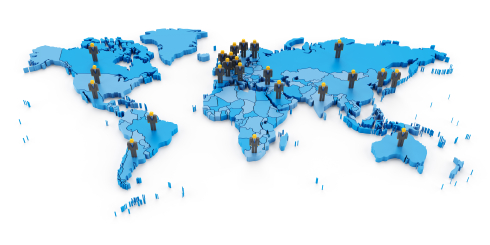 The balance of payments can cause problems for policy makers when there is either, a persistent deficit, or persistent surplus in one part of the Balance of payments.
The balance of payments can cause problems for policy makers when there is either, a persistent deficit, or persistent surplus in one part of the Balance of payments.
A large deficit (or even surplus) may need policies developed to correct it - particularly in the medium to long term. To a large extent, the growth of imports and exports will depend on the levels of economic growth domestically and overseas. Factors which influence changes in demand for exports and imports are as follows:
- Domestic economic growth will lead to a higher level of imports. The rate of growth of imports will depend on the income elasticity of demand for imports. An income elastic demand for imports will mean that imports grow faster than GDP. This will tend to lead to a balance of payments deficit.
- Economic growth in the rest of the world will lead to a higher level of exports. The rate of growth of exports will depend on the income elasticity of demand for exports. An income elastic demand for exports will mean that exports grow faster than GDP. This will help to prevent a balance of payments deficit.
- Changes in demand for exports and imports in response to price changes will depend upon the price elasticities of demand. The more price elastic is demand, the greater will be the responsiveness to any price change.
Therefore, the change in a country's balance of payments will depend on:
- The difference between the price elasticity of demand for exports and the price elasticity of demand for imports, and the rate of economic growth in that country compared to the rest of the world (and particularly its trading partners).
- The price competitiveness of that country's exports - this will be determined by productivity, the rate of inflation in that country compared to the rest of the world, and the exchange rate.
- The non-price competitiveness of that country's exports - this is dependent on factors like quality, reliability, after-sales service and so on.
On the following pages, we look in more detail at changes in the balance of payments and what we can do to correct them. We consider the following topics in detail:
- Consequences of deficit/surplus
- Methods of correction
- Consequences of capital account deficit/surplus
- Marshall-Lerner condition

Consequences of deficit / surplus

 A current account deficit, or surplus, will have serious consequences on an economy if they are sustained in the long-run.
A current account deficit, or surplus, will have serious consequences on an economy if they are sustained in the long-run.
Current account deficit
A current account deficit is generally thought to be undesirable (particularly in the long-run). In a sense, it is advantageous as the deficit means that the country is enjoying a higher standard of living in the short-term. This is thanks to the higher level of consumption through imports. However, the deficit is being funded by inflows of investment and this will mean interest and dividend payments flowing out of the country in the future. This inward investment also leaves the country more exposed to the whims of external investors. The greater the deficit, and the longer it lasts, the more of an issue this will be.

So, consider the question, "Does a deficit on a country's balance of payments on current account represent an economic problem?" Note down some points and then follow the link below to compare your answer with ours.
Does a current account deficit matter?
Current account surplus
A current account surplus is less of an issue than a deficit, but it does mean that the country may not be enjoying as high a standard of living as it might. Therefore, a current account surplus may be seen as an indication of under-performance.
A current account surplus, under a floating exchange rate system, is likely to exert upward pressure on the exchange rate, with all the problems, which that may cause.

Policies to correct a balance of payments disequilibrium

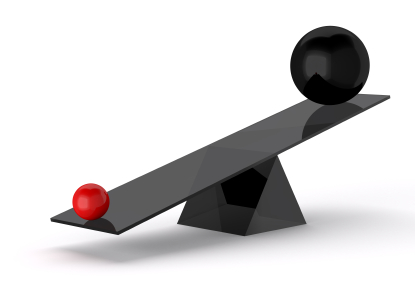 There are two types of policy to correct a balance of payments deficit. They are:
There are two types of policy to correct a balance of payments deficit. They are:
1. Expenditure-switching policies - these are policies that are aimed at encouraging people to switch their spending from imported goods to domestic goods. These policies might include tariffs and protectionism in general, manipulation of exchange rates to change the relative prices of imports and supply-side policies aimed at improving the competitiveness of domestic firms. In the past, countries have used marketing measures to promote the buying of national goods and services.
2. Expenditure-reducing policies - these are policies that aim to reduce domestic expenditure and therefore reduce the level of imports. The main expenditure-reducing policies are deflationary monetary and fiscal policies. These may include increasing tax, cutting government expenditure or increasing interest rates. The impact of these policies would be to reduce the level of aggregate demand and therefore the demand for imports. The extent of this improvement will depend on the income elasticity of demand for imports. The higher the income elasticity, the greater the improvement there will be in the current account.

Read the article 'Buy American' bill risks trade war and drift to protectionism and then answer the questions below. You can either read the article in the window below or you can follow the previous link to read the article in a separate window.

"Protectionism is the crackcocaine of economics. It may provide a high. It's addictive and it leads to economic death".
- Explain this view of Richard Fisher, president of the Dallas Federal.
- To what extent was Obama's campaign an unfair trade practice?

Consequences of a financial account deficit / surplus

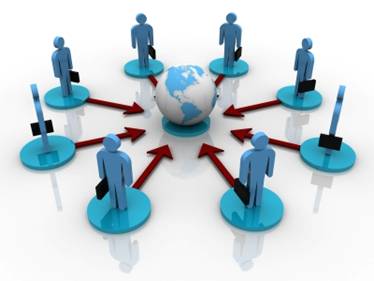 A surplus on the financial account means that there are more investment funds flowing into the country than flowing out. These inflows may be to fund a deficit on the current account of the balance of payments. Inward investment may help create jobs and boost growth, but anyone investing in an economy expects a return. Therefore, a surplus on the financial account will lead to outflows of interest and dividends in the future, thus affecting the balance on current account.
A surplus on the financial account means that there are more investment funds flowing into the country than flowing out. These inflows may be to fund a deficit on the current account of the balance of payments. Inward investment may help create jobs and boost growth, but anyone investing in an economy expects a return. Therefore, a surplus on the financial account will lead to outflows of interest and dividends in the future, thus affecting the balance on current account.
Any inflow of funds may exert an upward pressure on the exchange rate, as the demand for the domestic currency will increase. This may adversely affect the current account if the increase in export prices makes exports less competitive.
A financial account deficit, on the other hand, will mean a net outflow of investment funds. As a result, the country is building up a portfolio of overseas investments, which may lead to future returns of interest, profit and dividends. This may be beneficial in the medium-term. However, short term speculative outflows of funds may have disastrous effects on an economy in terms of the depreciation of the exchange rate, loss of confidence, impact on investment, output and jobs. Some countries have been badly affected by these speculative outflows of funds.

An Internet search will provide links to articles about the global financial crisis and the subsequent recovery of many economies. Select several of these and identify the reasons for the financial crisis.

Marshall-Lerner condition


Marshall-Lerner condition
The Marshall-Lerner condition refers to the impact of a depreciation, or devaluation, of a currency on the current account of the balance of payments. The condition states that the current account will improve, after a depreciation, if the sum of the price elasticities of demand for imports and exports is greater than 1. The further above 1 the sum of the elasticities is, the greater the improvement in the current account will be.
Marshall-Lerner condition - explanation
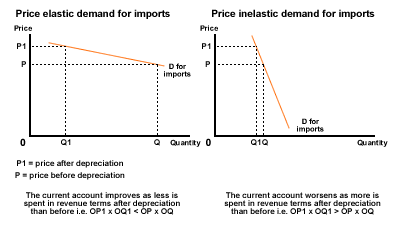
The depreciation of a currency will increase import prices and decrease export prices. Therefore, the more price elastic the demand for imports and exports, the greater will be the fall in demand for imports and the increase in demand for exports and the greater will be the improvement on the current account.
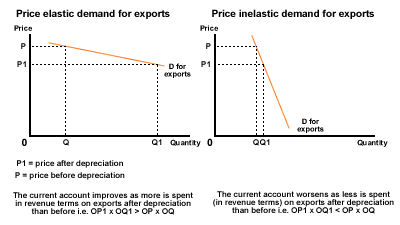
J-curve
Evidence around the world suggests that the Marshall-Lerner condition does not hold in the short-run, but does in the medium- to long-run. This is because in the short-run, there will be few extra exports sold when prices fall - people overseas do not react immediately and so export demand will take time to change. However, extra money will have to be paid for imports immediately and so the current account will tend to deteriorate. In the medium term, however, the lower export prices will lead to an increase in demand for exports and so the current account will start to improve. The price elasticity of demand for exports is lower in the short-run, but will be higher in the long-run.
This leads to the pattern shown in Figure 1 below - an initial deterioration of the trade balance followed by an improvement.
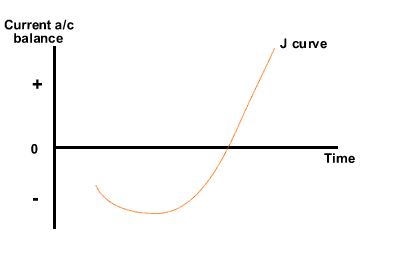
Figure 1 J-curve

Section 3.3 Balance of payments - questions
In this section are a series of questions on the topic - balance of payments. The questions may include various types of questions. For example:
- Self-test questions - on-screen questions that give immediate marking and feedback
- Short-answer questions - a series of short-answer questions to help you check your understanding of the topic
- Numerical - calculation questions
- In the news - questions based around a topical economics news article
Click on the right arrow at the top or bottom of the page to work through the questions.
Current account - short answer

Question 1
Explain the factors which are likely to affect a country's balance of payments on current account.
Question 2
Explain the possible effects of an increase in a country's level of interest rates on its balance of payments.
Question 3
Identify the components of the Canadian current account that will be affected by each of the following transactions, and calculate the net effect on their invisible balance of the balance of payments.
(a) a tourist from Spain spends $800 in Canada
(b) a multinational company operating in Canada makes $20,000 profit and sends this to Sweden
(c) a large corporation located in France pays interest of $55,000 on a loan from a Canadian bank
Question 4
The following information shows the income elasticity of demand for imports in three countries:
| Country | Income elasticity of demand for imports |
|---|---|
| A | 6.0 |
| B | 4.0 |
| C | 0.6 |
(a) Explain the term 'income elasticity of demand'.
(b) According to the figures for income elasticity, and assuming that exports stay constant, calculate which country will experience the biggest improvement in their balance of payments on current account from a recession.
The balance of payments - self-test questions

1 |
Balance of paymentsWhich of the following is NOT part of the balance of payments? |
2 |
International tradeWhich of the following would NOT be a good reason for a firm expanding trade into foreign countries? |
3 |
Inward investmentWhy might inward investment be an indicator of how competitive an economy is? |
4 |
Balance of payments deficitHow might a government attempt to reduce a medium term balance of payments deficit? |
5 |
Balance of payments policyWhich of the following would be an appropriate policy to reduce a balance of payments deficit? |
6 |
Fiscal policyHow can fiscal policy be used to decrease the level of economic activity in an economy? |
Balance of payments - calculation (1)



| Credits (+), Debits (-) | $m (2011) | |
|---|---|---|
| Current account | ||
| 1 | Exports of goods | ?? |
| 2 | Imports of goods | -3155 |
| 3 | Balance of trade in goods | -405 |
| 4 | Exports of services | 580 |
| 5 | Imports of services | -490 |
| 6 | Balance of trade in services | ?? |
| 7 | Income receipts (investment income) | 245 |
| 8 | Income payments (investment income) | ?? |
| 9 | Net income receipts (investment income) | -35 |
| 10 | Current transfers (net) | -55 |
| 11 | Net income flows | ?? |
| 12 | Current account balance | ?? |
| Capital account | ||
| 13 | Capital account transactions (net) | 250 |
| Financial account | ||
| 14 | Direct investment, net | 75 |
| 15 | Portfolio investment, net | ?? |
| 16 | Reserve assets funding | 65 |
| 17 | Errors and omissions | 60 |
| 18 | Capital and financial account balance | 405 |
Question 1
Define the following terms:
(a) Net current transfers
(b) Financial account
(c) Capital account
Question 2
Calculate the missing figures from the balance of payments account for Country Y given above and place them in the appropriate box.
Question 3
Suggest, and explain, the action(s) government will need to take to maintain a fixed exchange rate. .
Question 4
Evaluate two possible policies to correct the current account position country Y faces.

Balance of payments - calculation (2)



| Credits (+), Debits (-) | $m (2011) | |
|---|---|---|
| Current account | ||
| 1 | Exports of goods | 5850 |
| 2 | Imports of goods | -5250 |
| 3 | Balance of trade in goods | ?? |
| 4 | Exports of services | 2100 |
| 5 | Imports of services | -1900 |
| 6 | Balance of trade in services | ?? |
| 7 | Income receipts (investment income) | ?? |
| 8 | Income payments (investment income) | -525 |
| 9 | Net income receipts (investment income) | -50 |
| 10 | Current transfers (net) | 120 |
| 11 | Net income flows | ?? |
| 12 | Current account balance | 870 |
| Capital account | ||
| 13 | Capital account transactions (net) | -390 |
| Financial account | ||
| 14 | Direct investment, net | ?? |
| 15 | Portfolio investment, net | -160 |
| 16 | Reserve assets funding | -55 |
| 17 | Errors and omissions | -10 |
| 18 | Capital and financial account balance | ?? |
Question 1
Define the following terms:
(a) Direct investment
(b) Portfolio investment
(c) Errors and omissions
Question 2
Calculate the missing figures from the balance of payments account for Country Y given above and place them in the appropriate box.
Question 3
If country Y has a floating exchange rate system, draw a diagram to show the likely impact of the balance of payments situation shown above on the country's exchange rate.
Question 4
Evaluate two possible policies to correct the current account position country Y faces.

Methods of correction - short answer

Question 1
Explain two ways the government might attempt to reduce a deficit on the current account of the balance of payments.
Question 2
To what extent could the government afford to ignore a deficit on the current account of the balance of payments?
Question 3
Under a floating exchange rate system, a depreciation of the currency would normally be expected to eliminate a deficit on the current account of the balance of payments. Explain why this might not always happen.
Question 4
Explain how, in theory, a floating exchange rate system automatically corrects a balance of payments deficit without the need for government intervention.
Question 5
Evaluate how successful, in practice, a freely floating exchange rate system is likely to be in correcting a balance of payments deficit.
Question 6
Analyse how government policies aimed at reducing a balance of payments deficit might conflict with other goals of economic policy.
Balance of payments - essay

Question 1
(a) Explain the main implications for a country of having a persistent deficit on the current account of its balance of payments.
(b) Discuss the view that a current account deficit is most effectively tackled through a policy of domestic deflation.
Can the beast be tamed? America's monster trade gap
Read the article Trade Deficit in U.S. Unexpectedly Widens to $53.1 Billion and then answer the questions below. You can either read the article in the window below or you can follow the previous link to read the article in a separate window.

Question 1
Explain the factors that may have caused the rapid growth in America's trade gap.
Question 2
Identify the policies are available to the US government to try to close the trade gap? Assess how viable each of these policies may be in current circumstances.
Question 3
Discuss the implications for the rest of the world economy of the US taking significant action to close their trade gap.
Section 3.4 Economic integration - notes
In this section we will look at the various forms of economic integration including preferential trading agreements, trading blocs and monetary union.
By the end of this section you should be able to:

- Distinguish between bilateral and multilateral (WTO) trade agreements.
- Explain that preferential trade agreements give preferential access to certain products from certain countries by reducing or eliminating tariffs, or by other agreements relating to trade.
- Distinguish between a free trade area, a customs union and a common market.
- Explain that economic integration will increase competition among producers within the trading bloc.
- Compare and contrast the different types of trading blocs.
- Explain that a monetary union is a common market with a common currency and a common central bank.
- Discuss the possible advantages and disadvantages of a monetary union for its members.

- Explain the concepts of trade creation and trade diversion in a customs union.
- Explain that different forms of economic integration allow member countries to gain from economies of scale.
Economic integration - introduction
Did you know?

More than 1.3 million additional Western jobs will vanish by 2014 due to "the accelerated movement of work to India and other offshore locations"
(investprs.com)
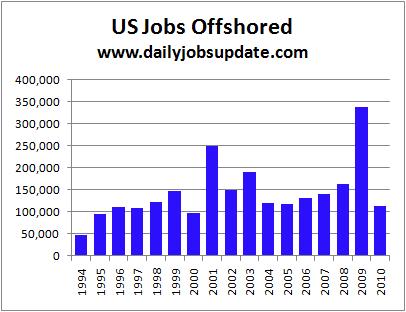
Improved productivity, technological development (e.g. e-commerce) and better transport infrastructures are all contributing to the world becoming more integrated and interconnected. Goods can be produced anywhere and transported to their markets worldwide. 'Off-shoring' means that many services can be run from other countries where the cost base is lower. Increased interdependency makes trade issues even more important.
On the following pages, we look in more detail at the following topics:
- Preferential trade agreements
- Trading blocs
- Trade creation and trade diversion
- Obstacles to achieving integration
Where does trade occur?
Trade between developed and emerging economies makes up the bulk of world trade and has grown significantly in recent years. The emerging economies include the BRIC countries of Brazil, Russia, China and India. The table below shows the leading exporters in world merchandise trade (excluding trade within the EU) in 2010. The significance of trade among the leading developed and emerging economies should be clear, with over 65% of world trade taking place between the top ten exporters on the list (N.B. the figures include the EU as a single bloc).
Look carefully also at the growth rates in the data (the last column). Pick out a number of developed countries and developing countries and compare the growth rates of their exports. This should give a clear indication of increasing globalisation.
| Rank | Exporters | Value | Share | Annual % change |
|---|---|---|---|---|
| 1 | Extra-EU (27) exports | 1787 | 15.0 | 17 |
| 2 | China | 1578 | 13.3 | 31 |
| 3 | United States | 1278 | 10.8 | 21 |
| 4 | Japan | 770 | 6.5 | 33 |
| 5 | Korea, Republic of | 466 | 3.9 | 28 |
| 6 | Hong Kong, China | 401 | 3.4 | 22 |
| 7 | Russian Federation | 400 | 3.4 | 32 |
| 8 | Canada | 387 | 3.3 | 22 |
| 9 | Singapore | 352 | 3.0 | 30 |
| 10 | Mexico | 298 | 2.5 | 30 |
| 11 | Taipei, Chinese | 275 | 2.3 | 35 |
| 12 | Saudi Arabia | 254 | 2.1 | 32 |
| 13 | United Arab Emirates | 235 | 2.0 | 27 |
| 14 | India | 216 | 1.8 | 31 |
| 15 | Australia | 212 | 1.8 | 38 |
| 16 | Brazil | 202 | 1.7 | 32 |
| 17 | Malaysia | 199 | 1.7 | 26 |
| 18 | Switzerland | 195 | 1.6 | 13 |
| 19 | Thailand | 195 | 1.6 | 28 |
| 20 | Indonesia | 158 | 1.3 | 32 |
| 21 | Norway | 132 | 1.1 | 9 |
| 22 | Turkey | 114 | 1.0 | 12 |
| 23 | Iran, Islamic Republic of | 101 | 0.8 | 28 |
| 24 | South Africa | 82 | 0.7 | 33 |
| 25 | Nigeria | 79 | 0.7 | 49 |
| 27 | VietNam | 72 | 0.6 | 26 |
| 27 | Chile | 70 | 0.6 | 30 |
| 28 | Argentina | 69 | 0.6 | 23 |
| 29 | Kuwait | 66 | 0.6 | 27 |
| 30 | Bolivarian Rep. of Venezuela | 66 | 0.6 | 14 |
Stages of economic integration
If you would prefer to view this interaction in a new web window, then please follow the link below:
Trade blocs
If you would prefer to view this interaction in a new web window, then please follow the link below:
The effects of trade blocs

If you would prefer to view this interaction in a new web window, then please follow the link below:

Obstacles to achieving integration

If you would prefer to view this interaction in a new web window, then please follow the link below:

Monetary union
A monetary union is a common market with a common/single currency and a common central bank. A single currency means that there cannot be separate national monetary policies within member countries, but requires the formation of a single central bank to take policy decisions on issues, such as the money supply and interest rates.
A significant example of monetary union was the introduction of the Euro in the European Union in 1999, with the full changeover to notes and coins taking place in January 2001. The members of the Eurozone are shown below.
The common central bank for the Eurozone is the European Central Bank.
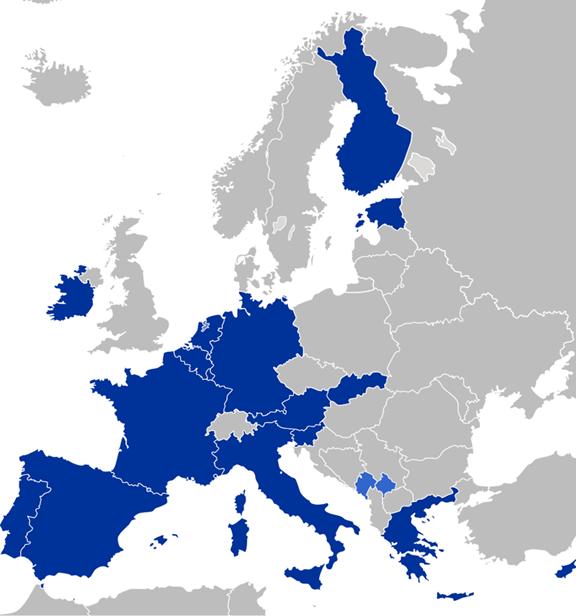

Other examples - currency unions
For some further examples of currency unions, browse the Wikipedia list of currency unions. You can do this in the window below or follow the previous link to open the page in a new web window.
Advantages & disadvantages of single currencies
If you would prefer to view this interaction in a new web window, then please follow the link below:
Section 3.4 Economic integration - questions
In this section are a series of questions on the topic - economic integration. The questions may include various types of questions. For example:
- Self-test questions - on-screen questions that give immediate marking and feedback
- Short-answer questions - a series of short-answer questions to help you check your understanding of the topic
- Numerical - calculation questions
- In the news - questions based around a topical economics news article
Click on the right arrow at the top or bottom of the page to work through the questions.
Trading blocs - essay

Question 1
(a) Explain the difference between trade creation and trade diversion.
(b) "The benefit of joining a trading bloc will always outweigh the costs". Do you agree? Justify your view.
Estonia becomes the 17th member of the euro zone
Read the article, Estonia becomes 17th member of the euro zone, and then answer the questions below. You can either read the article in the window below or you can follow the previous link to read the article in a separate window.
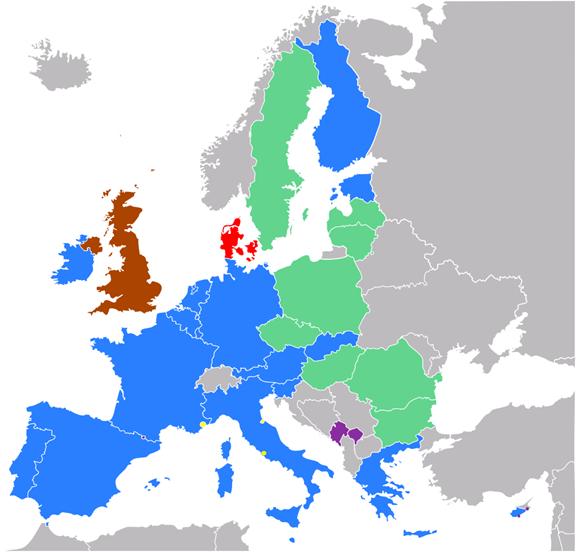


Question 1
Identify the other ex-soviet states which have already joined the euro zone.
Question 2
Describe what joining the euro zone proves for many Estonians.
Question 3
Evaluate the advantages and disadvantages for Estonia of joining a single currency.
Economic policy in the euro zone
Read the article,The two sides of the euro coin and then answer the questions below. You can either read the article in the window below or you can follow the previous link to read the article in a separate window.

Question 1
Compare the relative economic performance of Germany and Spain.
Question 2
Identify the important function carried out by the European Central Bank.
Question 3
Discuss the nature of economic adjustments required of the Spanish and German populations in response to the introduction of the single currency and compare and contrast reactions and effects in both countries.
Eurozone to consider closer economic scrutiny
Read the article, Eurozone to consider closer economic scrutiny, and then answer the questions below. You can either read the article in the window below or you can follow the previous link to read the article in a separate window.

You may also like to read the article Eurozone plans economic integration move, also from the BBC web site.

Question 1
Identify the evidence is there that the eurozone has been in crisis.
Question 2
Explain why is a 'shift to a higher level of policy co-ordination' in the eurozone is required.
Question 3
Examine the changes required in the new Pact.
A flat earth?
Read the article The new rules of the global game (you can do this in the window below or follow the previous link to read the article in a separate window) and then answer the questions below.

You may also like to read the article Why Bill Gates believes the world is flat.
You can also listen again to the BBC programme, The new rules of the game, May the force be with you (part 1), The dark side (part 2), The new rules and who makes them (part 3).

Question 1
Define the term globalisation.
Question 2
Explain why Bill Gates and Thomas Friedman believe the world is flat. Do you agree with their argument?
Question 3
Analyse the advantages and disadvantages of globalisation for (a) developed countries and (b) developing countries. You may find it helpful to listen to Part 2 of the Rules of the game (linked to above).
Question 4
Evaluate the impact that globalisation has had on our lives over the last decade.
Section 3.5 Terms of trade - notes
In this section we will look at the benefits of trade, absolute and comparative advantage, the World Trade Organisation (WTO), types of trade protection and arguments for and against trade protection.
By the end of this section you should be able to:

- Explain the meaning of the terms of trade.
- Explain how the terms of trade are measured.
- Distinguish between an improvement and a deterioration in the terms of trade.
- Calculate the terms of trade using the equation: Index of average export prices/index of average import prices x 100.
- Explain that the terms of trade may change in the short term due to changes in demand conditions for exports and imports, changes in global supply of key inputs (such as oil), changes in relative inflation rates and changes in relative exchange rates.
- Explain that the terms of trade may change in the long term due to changes in world income levels, changes in productivity within the country and technological developments.
- Explain how changes in the terms of trade in the long term may result in a global redistribution of income.
- Examine the effects of changes in the terms of trade on a country's current account, using the concepts of price elasticity of demand for exports and imports.
- Explain the impacts of short-term fluctuations and long-term deterioration in the terms of trade of economically less developed countries that specialize in primary commodities, using the concepts of price elasticity of demand and supply for primary products and income elasticity of demand.
Terms of trade - introduction
On the following pages, we look at the following topics in detail:
- Terms of trade
- Changes in terms of trade
- Impact of terms of trade
- The significance of a deteriorating terms of trade for developing countries
- Measurement of the terms of trade
- Changes in terms of trade - short run and long run
- Elasticity of demand for imports and exports
Terms of trade (TOT)
The terms of trade measures the purchasing power of a country's exports, e.g. how many units of exports are needed to buy a unit of imports. As each country is exporting and importing many different products, the Terms of Trade are calculated using the export price index (shows combined price changes of all exported products) and import price index (shows the combined changes in prices of all imported goods).
![]()
An improvement in the terms of trade must mean that one of the following changes has taken place:
- Export prices have risen, import prices have stayed the same
- Export prices have risen, import prices have fallen
- Export prices have risen faster than import prices
- Export prices have fallen by less than import prices
- Export prices have stayed the same but import prices have fallen
A increase in the terms of trade ratio is generally described as an improvement, or favourable movement, in the terms of trade. This is because the same volume of exports will now buy more imports.
A decrease in the terms of trade ratio is generally described as a deterioration, or a worsening or unfavourable movement, in the terms of trade. This is because the country can afford fewer imports with the same volume of exports.

Task - Terms of trade
Go to the national statistics for the country where you live and find the terms of trade figures for recent years. To find the National Statistics sites for different countries, you could use the OFFSTATS site. Select the 'Browse' link and then the country you require. This will give links usually to the National Statistics provider for each country. Consider the changes that have taken place and assess how these may have affected the economy. Once you have done this move onto the next section to see what the changes might mean.
Now, what about a deterioration in the terms of trade? What changes have happened to export and import prices to cause this? Have a think about this and then follow the DECREASE in terms of trade link to compare your thoughts with ours.
Impact of terms of trade on the balance of payments
 An improvement in terms of trade does not necessarily mean an improvement in the balance of payments.
An improvement in terms of trade does not necessarily mean an improvement in the balance of payments.
If the terms of trade improve, this means that export prices have increased more than import prices. This may, however, indicate a deterioration in competitiveness and in the medium-term may lead to a fall in export demand. How much export demand falls will depend on the price elasticity of demand for exports. This may adversely affect the balance of payments.
Similarly, a deterioration in the terms of trade may actually indicate an improvement in competitiveness. This is because import prices have risen more than export prices, possibly showing that exports are more competitive. In the medium-term demand for exports may rise and lead to an improvement in the current account.
The effect of changes in the terms of trade on the balance of payments will depend on the price elasticities of demand for imports and exports.
Elasticity of demand for imports and exports
A favourable movement in the terms of trade may have an unfavourable effect on the trade balance, while an unfavourable movement in the terms of trade may favourably affect the trade balance. This is because the terms of trade records relative price movements of exports and imports, while the current account of the balance of payments is concerned with export and import values (price x quantity bought / sold).
The impact of a change in the terms of trade on the trade balance will largely depend on the price elasticity of demand for exports and imports.
An improvement (favourable movement) in the terms of trade may worsen the trade balance - this will occur when the demand for exports and imports is price elastic.
An improvement in the terms of trade means that the price of exports increases relative to the price of imports.
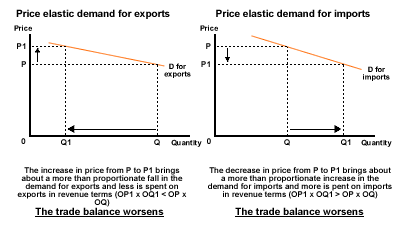
Impact of an increase in terms of trade on balance of payments
A deterioration (unfavourable movement) in the terms of trade may improve the trade balance. This will occur when the demand for exports and imports is price elastic.
A worsening of the terms of trade means that the price of imports increases relative to the price of exports.
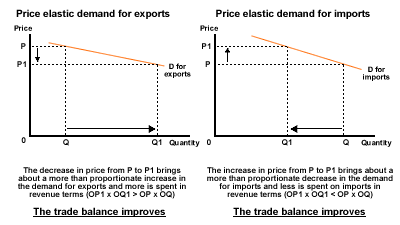
Impact of a decrease in terms of trade on balance of payments
The overall impact on the balance of payments of a change in the terms of trade depends on the combined price elasticities of demand for imports and exports. So:
- An improvement in the terms of trade will worsen the balance of payments if the demand for exports and imports is price elastic, and improve it if demand for exports and imports is price inelastic.
- A deterioration in the terms of trade will worsen the balance of payments if the demand for exports and imports is price inelastic and improve it if demand is price elastic.
Given that the developing countries' demand for exports and imports is relatively price inelastic, they have faced ever worsening balance of payments situations in response to their deteriorating terms of trade.
Impact of terms of trade on the economy
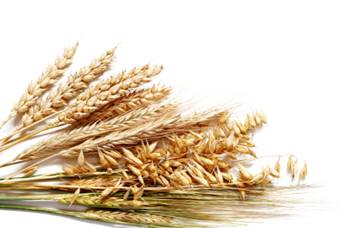 Prices of commodities are more volatile than for manufactured goods. Many developing countries are vulnerable to deterioration in the terms of trade, because they are very dependent on exports of primary commodities - minerals, agricultural commodities like coffee etc. If prices of these commodities on world markets fall, then they face a deterioration in their terms of trade. They are earning less from the same volume of exports and this means that they cannot afford to import as much. Their standard of living has fallen, not because of anything they did, but simply due to the vagaries of world markets.
Prices of commodities are more volatile than for manufactured goods. Many developing countries are vulnerable to deterioration in the terms of trade, because they are very dependent on exports of primary commodities - minerals, agricultural commodities like coffee etc. If prices of these commodities on world markets fall, then they face a deterioration in their terms of trade. They are earning less from the same volume of exports and this means that they cannot afford to import as much. Their standard of living has fallen, not because of anything they did, but simply due to the vagaries of world markets.
The impact of changes in the terms of trade on the standard of living:
- An improvement in the terms of trade may improve the standard of living in a country - the same volume of exports will buy more imports.
- A deterioration in the terms of trade may reduce the standard of living as more exports have to be sold to pay for the same volume of imports.
Causes of changes in the Terms of Trade
Causes of changes in terms of trade in the short run and long-run:
Short-run
The terms of trade is the price relationship between a country's exports and imports and will, therefore, be influenced by all the factors which determine the prices of imports and exports.
In the short-run, changes in relative prices of imports and exports will be caused by fluctuations in exchange rates, particularly where countries operate a floating exchange rate system. Exchange rate volatility may be caused by changes in trade, capital flows, interest rates, speculation, inflation and use of foreign currency reserves by the government.
You will recall that a depreciation of the exchange rate causes import prices to increase and export prices to decrease, while an appreciation causes the opposite effects.
Also in the short-run, there may be considerable fluctuation in the prices of commodities which will affect the terms of trade. This is particularly true for agricultural commodities, the supply of which is often affected by drought, floods, diseases, etc. Given that the demand for and supply of these commodities is highly inelastic the change in supply will cause a proportionately greater change in price.
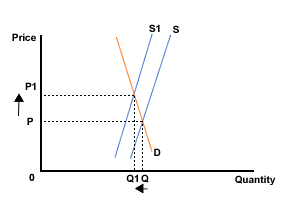
Figure 1 Impact on price of primary commodities
In Figure 1, the relative inelasticities of demand and supply have caused a large fall in price in response to the increase in supply from S to S1. Try drawing the same diagram with more elastic demand and supply curves and note the less pronounced effect on price.
Long-run
In the longer term, changes in the terms of trade are likely to be determined by those factors which exert a long term influence on the demand for, and supply of, a country's exports and imports.
For the developing countries, who export mainly primary goods and import manufactured goods, their export prices have tended to fall over time due to a combination of increased supply of and reduced demand for their exports:
- Supply has increased, mainly due to improvements in technology and, in the case of coffee, new producers entering the market.
- Demand has fallen / not risen rapidly, for a variety of reasons.
The reasons for demand falling include:
- Development of synthetic substitutes, e.g. plastics have lessened the demand for several raw materials.
- Low income elasticity of demand for primary commodities - as real world incomes have grown, the demand for primary commodities has increased less than proportionately.
- Agricultural protection - the developing countries, despite producing at lower cost, have found it difficult to break into the markets of the richer countries, as farmers there are often heavily subsidised and, in the case of the European Union, protected by a common external tariff.
- Miniaturisation - modern microchip technologies have enabled products to become smaller, e.g. the personal computer, and this has necessitated less use of raw materials and caused demand to fall.
- Price inelastic demand for exports of primary commodities - compounding the problem of falling export prices, demand for primary commodities tends to be price inelastic, such that decreases in prices bring about less than proportionate increases in the quantity demanded.
The above is in sharp contrast to the situation faced by the more developed countries - the export prices of their manufactured goods has risen over time (high income elasticity of demand, multinational / monopoly control over supply and price) and they have benefited from cheaper import prices of primary commodities due to the factors described above.
Section 3.5 Terms of trade - questions
In this section are a series of questions on the topic - terms of trade. The questions may include various types of questions. For example:
- Self-test questions - on-screen questions that give immediate marking and feedback
- Short-answer questions - a series of short-answer questions to help you check your understanding of the topic
- Numerical - calculation questions
- In the news - questions based around a topical economics news article
Click on the right arrow at the top or bottom of the page to work through the questions.
Impact of terms of trade - essays

Question 1
An improvement on the current account of the balance of payments might come about as a result of a deterioration in the terms of trade. Explain why this might be so.
Question 2
(a) Identify reasons for changes in the terms of trade.
(b) Identify and explain reasons for the deterioration of the terms of trade in many developing countries.
(c) Evaluate the impact on developing countries of a long term worsening in their terms of trade.
Malawi's Economic Direction
Read the article, The misplaced either/or question (you can do this in the window below or follow the previous link to read the article in a separate window).

The author of this article asks the question, 'why has the country (Malawi) failed to translate political independence attained in 1964 into economic independence?'
Produce a 500 - 750 word report summarising Malawi's economic problems and examining the factors leading to the deterioration in the country's trading position.

